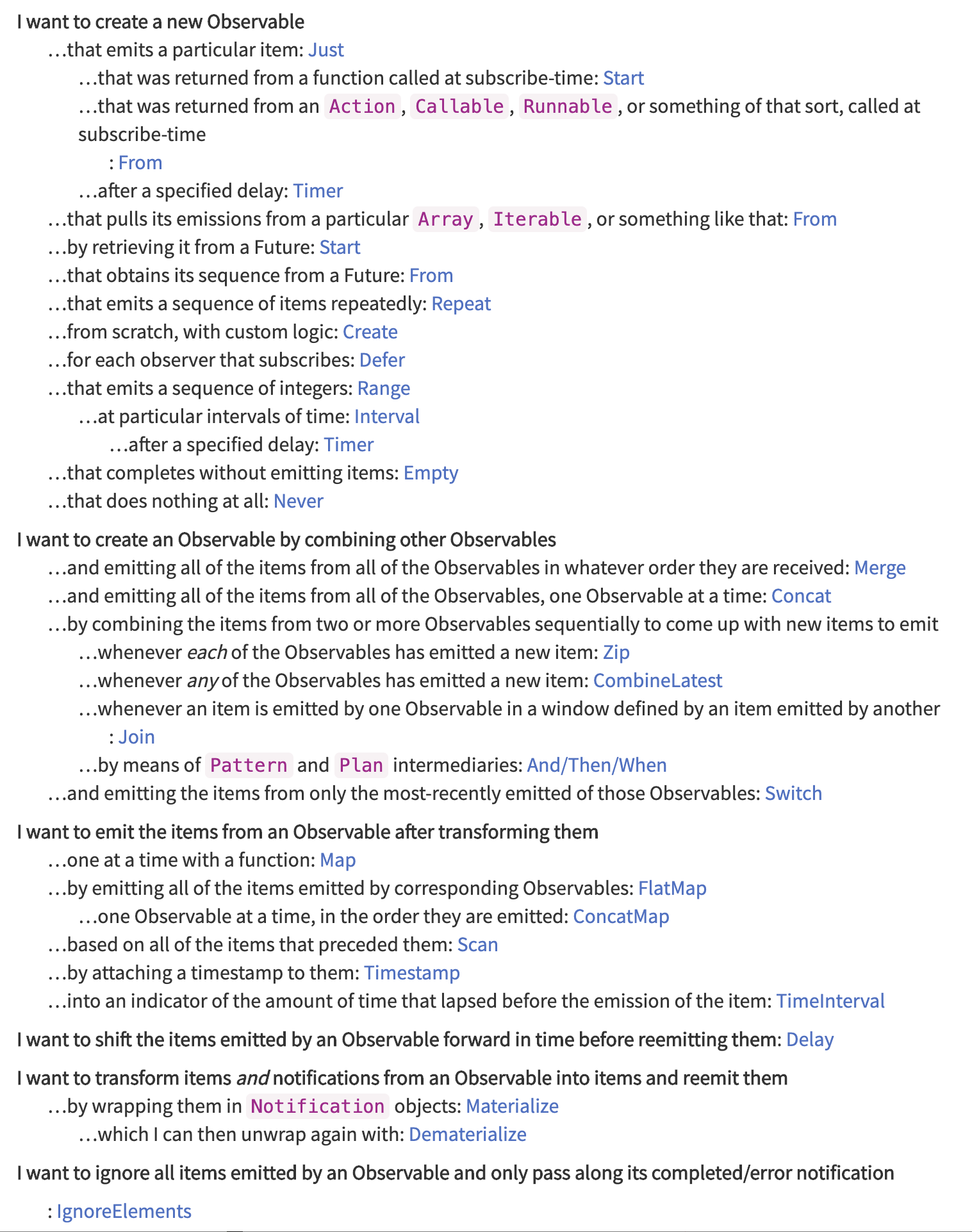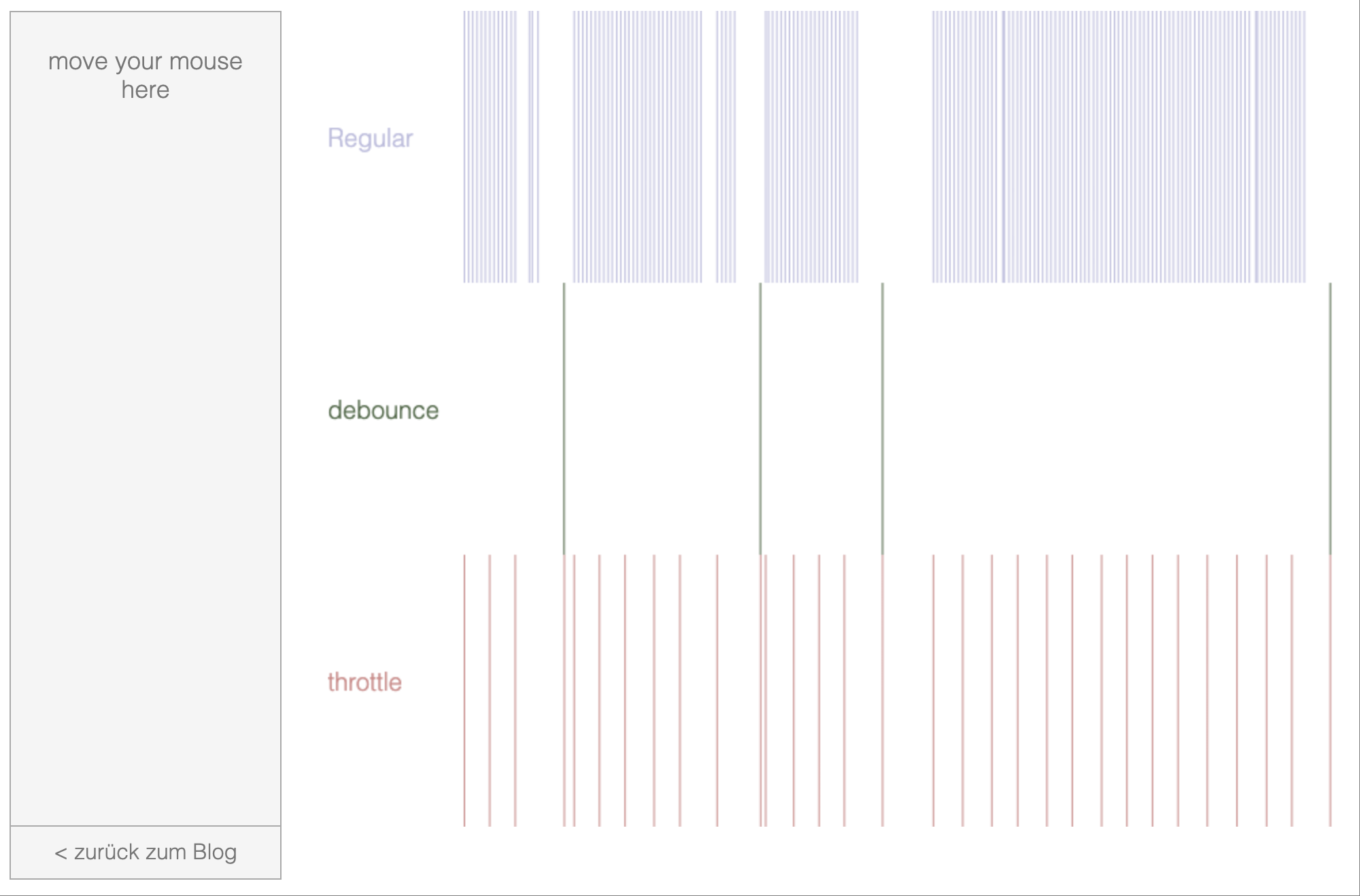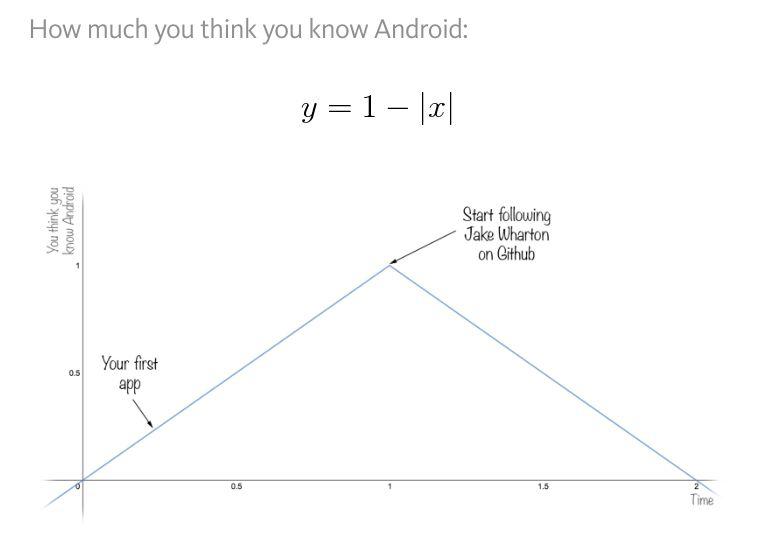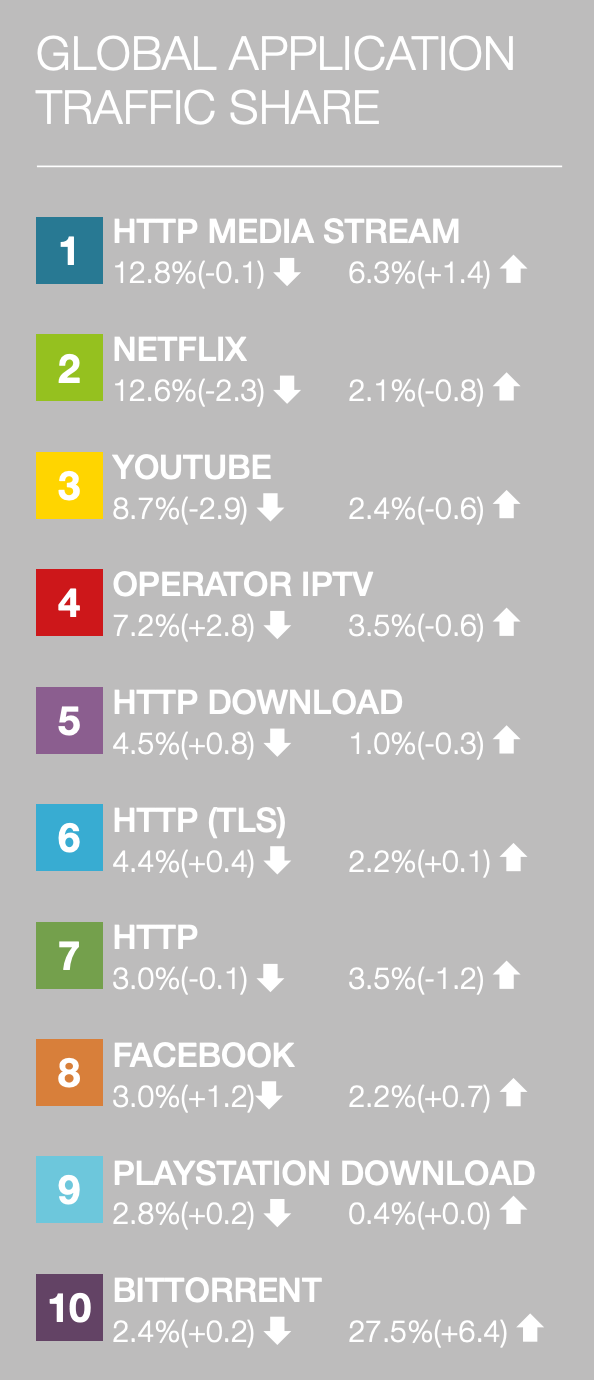Reactive programming
Dmitry Melnikov
What is Reactive Programming?
What is Reactive Programming?
Wikipedia
Reactive programming is a declarative programming paradigm concerned with data streams and the propagation of change. With this paradigm it is possible to express static (e.g., arrays) or dynamic (e.g., event emitters) data streams with ease, and also communicate that an inferred dependency within the associated execution model exists, which facilitates the automatic propagation of the changed data flow.
Is too generic and theoretical as usual.
What is Reactive Programming?
Stackoverflow
https://stackoverflow.com/questions/1028250/what-is-functional-reactive-programming
Stackoverflow's canonical answer is obviously not suitable for newcomers.
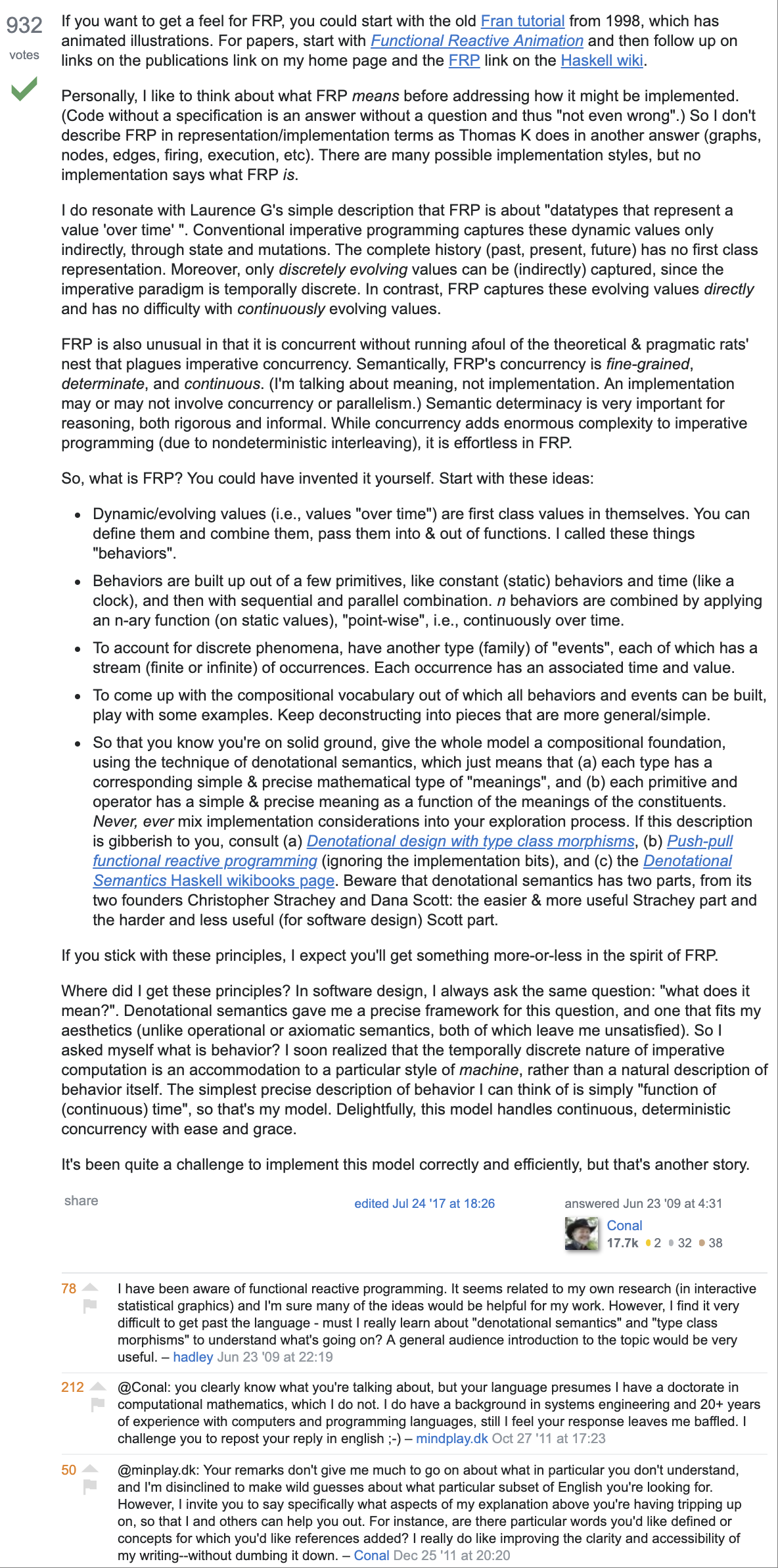
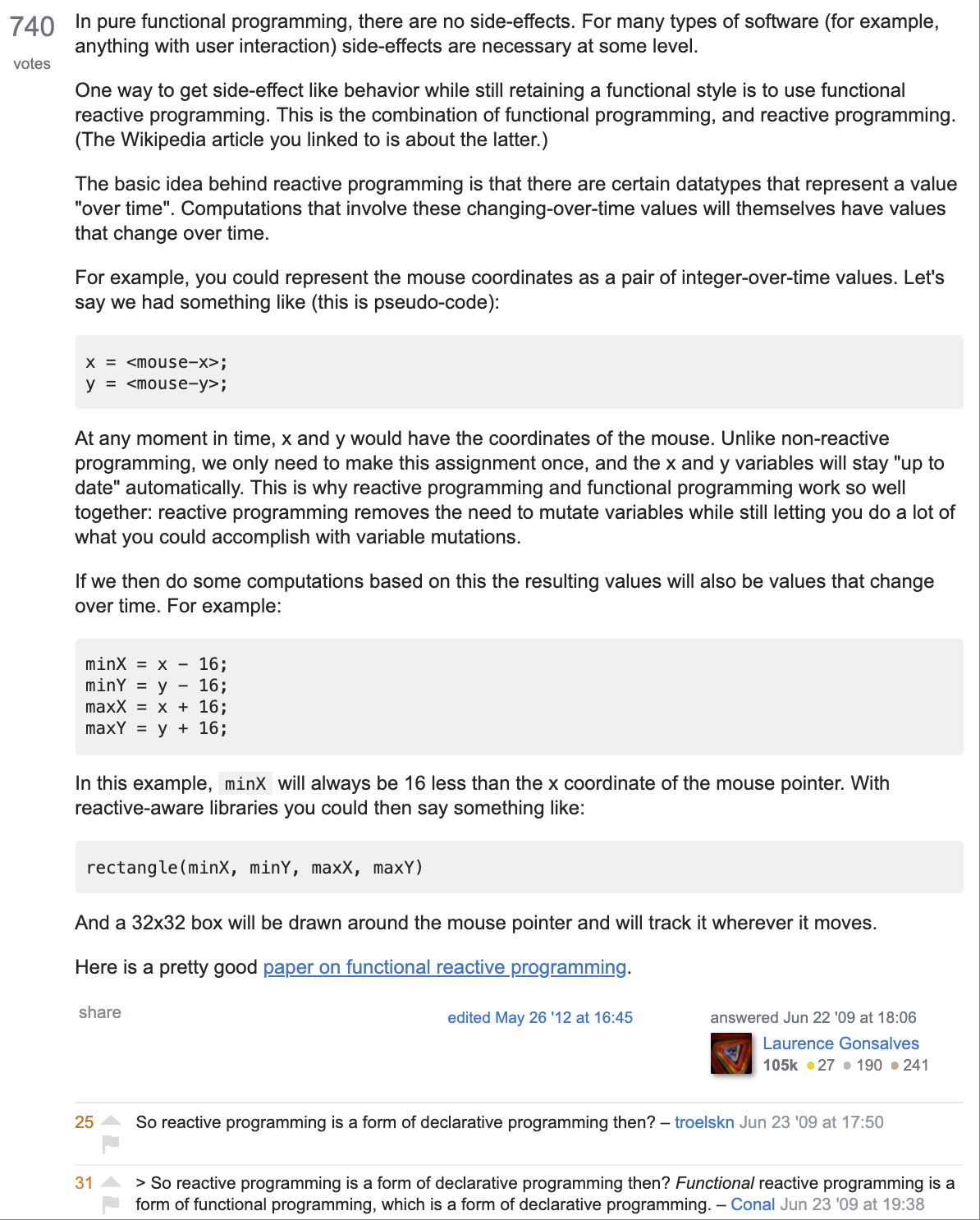
What is Reactive Programming?
Reactive Manifesto
Reactive Manifesto sounds like the kind of thing you show to your project manager or the businessmen at your company.
https://www.reactivemanifesto.org/
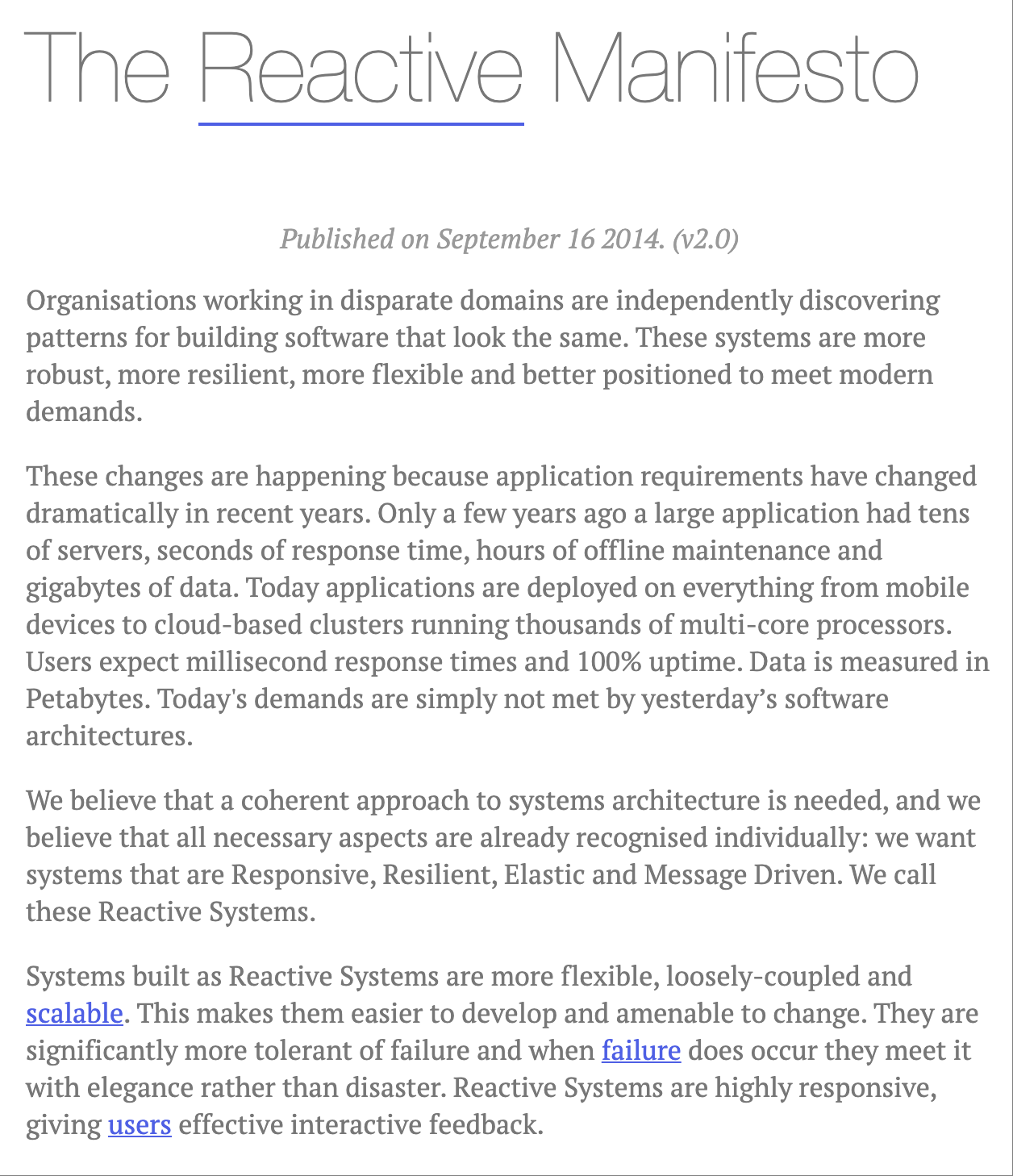
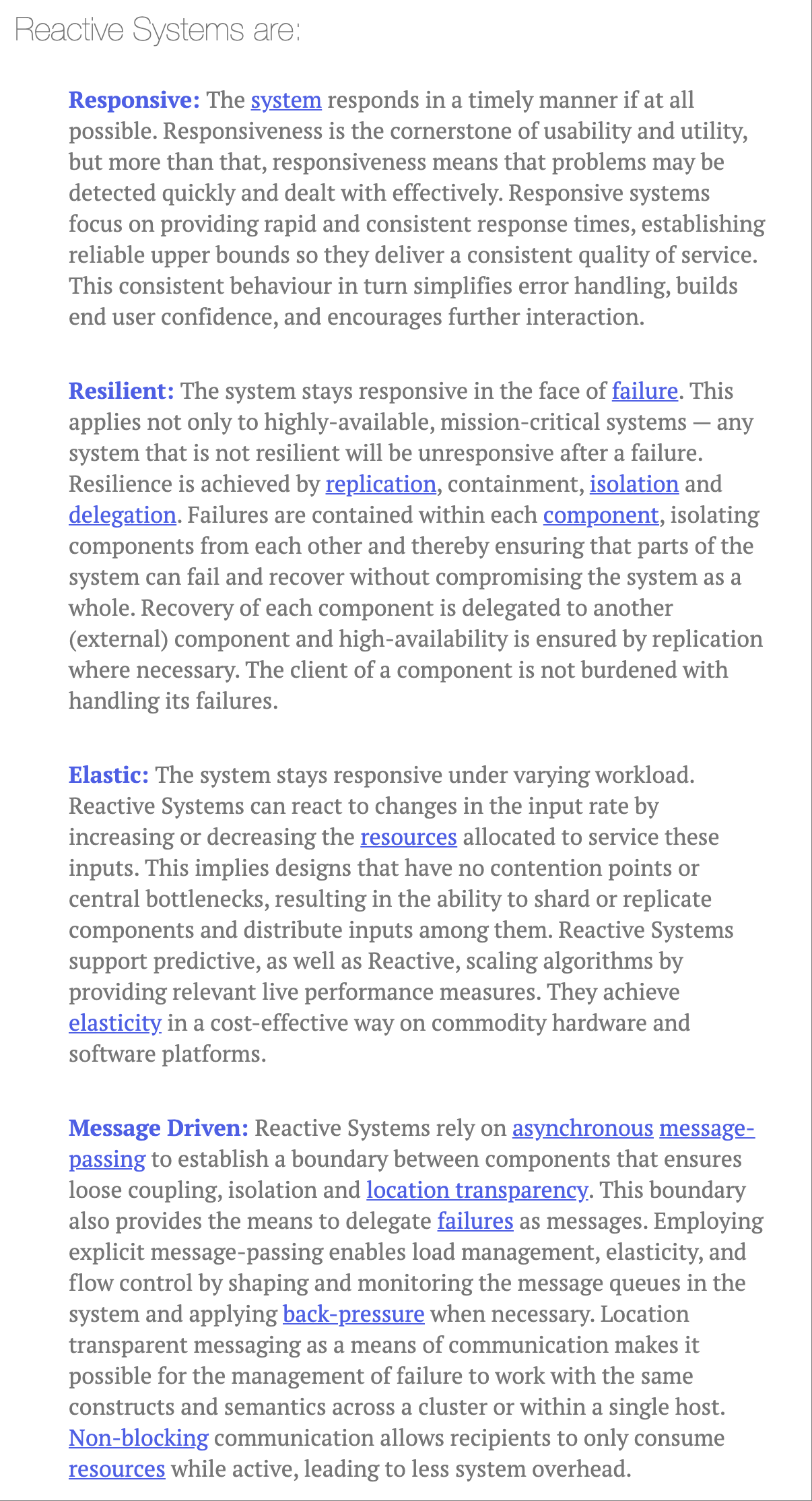
What is Reactive Programming?
Microsoft
Microsoft's Rx terminology is so heavy and Microsoftish that most of us are left confused.
The Reactive Extensions (Rx) is a library for composing asynchronous and event-based programs using observable sequences and LINQ-style query operators.
https://archive.codeplex.com/?p=rx
Rx = Observables + LINQ + Schedulers
What is Reactive Programming?
Other
Terms like "reactive" and "propagation of change" don't convey anything specifically different to what your typical MV* and favorite language already does.
Of course my framework views react to the models. Of course change is propagated. If it wouldn't, nothing would be rendered.
What is Reactive Programming?
Simple definition
Reactive programming is programming with asynchronous data streams.
Idea
It's not new. Event buses or click events in your projects are an asynchronous event streams.
Reactive is that idea on steroids.
Create streams. It's cheap. Anything can be source: var, list, input, caches, etc.
On top is toolbox with stream manipulations: combine, create, filter, map and other operations.
Idea
Example
a = b + cImperative programming
change b:
b = 2
a stays the same until:
a = b + c
Reactive programming
change b:
b = 2
a automatically recalculated
Idea
A stream is a sequence of ongoing events ordered in time.
Idea
--a---b-c---d---X---|->
is a marble diagram
a, b, c, d are emitted values
X is an error
| is a 'completed' signal
---> is a timeline
It can emit three different things:
- value
- error
- completed signal
Idea
We capture these emitted events only asynchronously, by defining a function that will execute when a value is emitted, another function when an error is emitted, and another function when 'completed' is emitted.
Subscribing is the "listening" to the stream.
Observers are the functions we are defining.
Subject/Observable is the stream is being observed.
RxJava basics
fun simpleObservable01() { val stringObservable = Observable.create<String> { emitter -> /* do some work here, e.g. request to a server or a database */ }}RxJava basics
fun simpleObservable02() { val stringObservable = Observable.create<String> { emitter -> /* do some work here, e.g. request to a server or a database */ emitter.onNext("some value") } stringObservable.subscribe( { value -> /* handle result */ }, { throwable -> /* handle error */ }, )}RxJava basics
fun simpleObservable03() { val stringObservable = Observable.create<String> { emitter -> /* do some work here, e.g. request to a server or a database */ emitter.onNext("some value") } stringObservable .subscribeOn(Schedulers.io()) .observeOn(AndroidSchedulers.mainThread()) .subscribe( { value -> /* handle result */ }, { throwable -> /* handle error */ }, )}RxJava basics
fun simpleObservable04() { val stringObservable = Observable.create<String> { emitter -> /* do some work here, e.g. request to a server or a database */ emitter.onNext("some value") } stringObservable .subscribeOn(Schedulers.io()) .observeOn(AndroidSchedulers.mainThread()) .filter { emittedValue -> emittedValue.length > 5 } .doOnComplete { /* completion handler */ } .subscribe( { value -> /* handle result */ }, { throwable -> /* handle error */ }, )}RxJava basics
fun simpleObservable05() { val stringObservable = Observable.create<String> { emitter -> while (!emitter.isDisposed) { /* do some intensive work in a loop */ /* if emitter is not disposed */ emitter.onNext("more values") } } val disposable = stringObservable .subscribeOn(Schedulers.io()) .observeOn(AndroidSchedulers.mainThread()) .filter { emittedValue -> emittedValue.length > 5 } .subscribe( { value -> /* handle result */ }, { throwable -> /* handle error */ }, { /* completion handler */ } ) /* to interrupt work */ disposable.dispose()}Reasoning
It's hard to reason about reactive programming.
Why reactive programming? Why RxJava? Where is Android?
Why should we learn this?
Story about cars and horses
We are in 19th century

Story about cars and horses
Horses are main transpotation

Story about cars and horses
Somebody from future shows you a car

Story about cars and horses
How to use it?

Story about cars and horses
Driving signs and conventions

Story about cars and horses
Learning and exams

Story about cars and horses
Parallel parking

Story about cars and horses
Roads

Story about cars and horses
You seat at the car and nothing happens

Story about cars and horses
You love horses

Story about cars and horses
Conquer a whole continent

Story about cars and horses
Nothing bad about horses

Story about cars and horses
but cars are better

Challenges
Software requirements changed
| Resource | 10 years ago | now | |
|---|---|---|---|
| Server nodes | 10's | 1000's | |
| Response times | seconds | milliseconds | |
| Maintenance downtimes | hours | none | |
| Data volume | GBs | TBs -> PBs | |
| Clients | 1-2 | up to 10's |
Challenges
Complexity
Technologies count is constantly increasing
Learning curve is high
Complexity is proportional to software size
Challenges
Costs
Software development
Hardware
Maintenance
Challenges

Reactive programming history
Founders and evangelists
Erik Meijer, reactive programming author in Cloud Programmability Team in Microsoft (in ≈2006).
David Karnok, Research Assistant at MTA SZTAKI (Hungary, Budapest) .
He started in 2010 and made reactive programming in java 2 years before Netflix.
In 2011 published reactive4java.
In 2013 he merged efforts with Netflix to create RxJava.
Now RxJava counts more than 5k commits since then.
Ben Christensen, one of men behind Netflix API, RxJava and more, now a Facebook engineer.
Reactive programming history
Other important people
Jonas Bonér and Roland Kuhn ‒ creators of Akka (Lightbend) and Reactive Manifesto authors.
Stephane Maldini, project Reactor lead, prinipal engineer at Pivotal.
André Staltz, JavaScript expert and reactive programming evangelist.
Martin Odersky, creator of Scala.
JVM implementations
Java <9 CompletableFuture / Java 9 http://www.reactive-streams.org
RxJava https://github.com/ReactiveX/RxJava
Reactor https://projectreactor.io
Coroutines Channels and Flow https://github.com/Kotlin/kotlinx.coroutines
Akka in Scala
Android
RxJava
Targets older Java version (Java6 for RxJava v1 and v2, Java8 for RxJava v3)
A mature and solid library
Coroutines Channels and Flow
Pre basics
Iterator pattern
https://en.wikipedia.org/wiki/Iterator_pattern
Problems to solve
- the elements of an aggregate object should be accessed and traversed without exposing its representation (data structures)
- new traversal operations should be defined for an aggregate object without changing its interface
Solution
- define a separate (iterator) object that encapsulates accessing and traversing an aggregate object
- clients use an iterator to access and traverse an aggregate without knowing its representation (data structures)
Pre basics
Observer pattern
https://en.wikipedia.org/wiki/Observer_pattern
Problems to solve
- a one-to-many dependency between objects should be defined without making the objects tightly coupled
- it should be ensured that when one object changes state an open-ended number of dependent objects are updated automatically
- it should be possible that one object can notify an open-ended number of other objects
Solution
- define Subject and Observer objects
- so that when a subject changes state, all registered observers are notified and updated automatically
Basics
Just a stream of data events, but made right
RxJava
push vs pull (backpressure)
async vs sync
concurrency and parallelism (onNext(), onCompleted(), onError() cannot be emmited concurrently, aka thread-safe)
Observable.create<String> { emitter -> Thread { emitter.onNext("one") emitter.onNext("two") emitter.onNext("three") emitter.onNext("four") emitter.onComplete() }.start()}RxJava
Do not do this
/* DO NOT DO THIS */Observable.create<String> { emitter -> Thread { emitter.onNext("one") emitter.onNext("two") emitter.onComplete() }.start() Thread { emitter.onNext("three") emitter.onNext("four") emitter.onComplete() }.start()}Why not just allow onNext() to be invoked concurrently?
- defensive code to check threads
- some operations has to be sync (scan/reduce) to accumulate data
- performance
RxJava
Do this instead
val a = Observable.create<String> { emitter -> Thread { emitter.onNext("one") emitter.onNext("two") emitter.onComplete() }.start()}val b = Observable.create<String> { emitter -> Thread { emitter.onNext("three") emitter.onNext("four") emitter.onComplete() }.start()}val c = Observable.merge(a, b)RxJava
Lazy vs Eager
Subscription, not construction starts work
Observables can be reused
Duality
An Rx Observable is the async "dual" of an Iterable
Cardinality
The Observable supports asynchronously pushing multiple values
| Type | One | Many | |
|---|---|---|---|
| synchronous | T getData() |
Iterable<T> getData() |
|
| asynchronous | Future<T> getData() |
Observable<T> getData() |
Functional reactive programming
asynchronous values events pushfunctional reactivelambdasclosurespurecomposableFunctional code is idempotent, depends only on arguments.
Pure functions has no side-effects (no state).
The essence and origins of FRP https://github.com/conal/talk-2015-essence-and-origins-of-frp .
Reactive manifesto
- message-driven (react to events / event-driven)
- elastic (react to load / scalable)
- resilient (react to failures)
- responsive (react to users)
responsive ↗ ↖scalable ↑ resilient ↖ ↗ message-drivenReactive Manifesto https://www.reactivemanifesto.org
Reactive Manifesto 2.0 https://www.lightbend.com/blog/reactive-manifesto-20
RxJava formal definition
RxJava is a Java VM implementation of Reactive Extensions: a library for composing asynchronous and event-based programs by using observable sequences.
It extends the observer pattern to support sequences of data/events and adds operators that allow you to compose sequences together declaratively while abstracting away concerns about things like low-level threading, synchronization, thread-safety and concurrent data structures.
Source: https://github.com/ReactiveX/RxJava
RxJava contract
An Observable is the asynchronous "dual" to the synchronous/pull Iterable
| event | Iterable (pull) | Observable | |
|---|---|---|---|
| retrieve data | T next() |
onNext(T) |
|
| discover error | throws Exception |
onError(Exception) |
|
| complete | returns |
onCompleted() |
Completable (0 emits)
Single (1 emit)
Observable/Flowable (many emits)
Completable.fromRunnable { Thread.sleep(1000) } .subscribe { println("took ${System.currentTimeMillis() - now} ms") }Single.fromCallable { calcSomeValue() } .subscribe { result -> showCalcedResult(result) }Asynchronous operations
Simple Futures usage
https://gist.github.com/benjchristensen/4670979
class FuturesA { void someMethod() { Future<String> f1 = executor.submit(new CallToRemoteServiceA()); Future<String> f2 = executor.submit(new CallToRemoteServiceB()); System.out.println(f1.get() + " - " + f2.get()); }}Asynchronous operations
How easily Futures can become blocking and prevent other work
https://gist.github.com/benjchristensen/4671081
class FuturesA { void someMethod() { // get f3 with dependent result from f1 Future<String> f1 = executor.submit(new CallToRemoteServiceA()); Future<String> f3 = executor.submit(new CallToRemoteServiceC(f1.get())); // The work below can not proceed until f1.get() // completes even though there is no dependency // also get f4/f5 after dependency f2 completes Future<Integer> f2 = executor.submit(new CallToRemoteServiceB()); Future<Integer> f4 = executor.submit(new CallToRemoteServiceD(f2.get())); Future<Integer> f5 = executor.submit(new CallToRemoteServiceE(f2.get())); System.out.println(f3.get() + " => " + (f4.get() * f5.get())); }}Asynchronous operations
Demonstrates how reordering of Future.get() can improve the situation but that it still doesn't address differing
response latencies of f1 and f2
https://gist.github.com/benjchristensen/4671081
class FuturesA { void someMethod() { // kick of f1/f2 in parallel Future<String> f1 = executor.submit(new CallToRemoteServiceA()); Future<Integer> f2 = executor.submit(new CallToRemoteServiceB()); // get f3 with dependent result from f1 (blocks) Future<String> f3 = executor.submit(new CallToRemoteServiceC(f1.get())); // The work below can not proceed until f1.get() // completes even if f2.get() is done. // get f4/f5 after dependency f2 completes (blocks) Future<Integer> f4 = executor.submit(new CallToRemoteServiceD(f2.get())); Future<Integer> f5 = executor.submit(new CallToRemoteServiceE(f2.get())); System.out.println(f3.get() + " => " + (f4.get() * f5.get())); }}Asynchronous operations
Demonstrate how changing where threads are injected can solve the issue of previsous example at the cost of incidental complexity being added to the code.
This same example could be accomplished by refactoring CallToRemoteServiceC to accept a Future<String> instead
of String but the principle is the same.
https://gist.github.com/benjchristensen/4671081
Asynchronous operations
class FuturesA { void someMethod() { // kick of f1/f2 in parallel final Future<String> f1 = executor.submit(new CallToRemoteServiceA()); Future<Integer> f2 = executor.submit(new CallToRemoteServiceB()); // spawn in another thread so waiting on f1 for f3 doesn't block f4/f5 Future<String> f3 = executor.submit(new Callable<String>() { @Override public String call() throws Exception { // get f3 with dependent result from f1 (blocks) return new CallToRemoteServiceC(f1.get()).call(); } }); // The following can now proceed as soon as f2.get() // completes even if f1.get() isn't done yet // get f4/f5 after dependency f2 completes (blocks) Future<Integer> f4 = executor.submit(new CallToRemoteServiceD(f2.get())); Future<Integer> f5 = executor.submit(new CallToRemoteServiceE(f2.get())); System.out.println(f3.get() + " => " + (f4.get() * f5.get())); }}Asynchronous operations
Demonstrate typical handling of responding to Futures as they complete.
This successfully executes multiple calls in parallel but then synchronously handles each response in the order they were put in the list rather than the order they complete.
https://gist.github.com/benjchristensen/4671081
Asynchronous operations
class FuturesA { void someMethod() { List<Future<?>> futures = new ArrayList<Future<?>>(); // kick off several async tasks futures.add(executor.submit(new CallToRemoteServiceA())); futures.add(executor.submit(new CallToRemoteServiceB())); futures.add(executor.submit(new CallToRemoteServiceC("A"))); futures.add(executor.submit(new CallToRemoteServiceC("B"))); futures.add(executor.submit(new CallToRemoteServiceC("C"))); futures.add(executor.submit(new CallToRemoteServiceD(1))); futures.add(executor.submit(new CallToRemoteServiceE(2))); futures.add(executor.submit(new CallToRemoteServiceE(3))); futures.add(executor.submit(new CallToRemoteServiceE(4))); futures.add(executor.submit(new CallToRemoteServiceE(5))); // as each completes do further work for (Future<?> f : futures) { // this blocks so even if other futures in the list complete // earlier they will wait until this one is done doMoreWork(f.get()); } }}Asynchronous operations
Demonstrate polling approach to handling Futures as they complete. This becomes unwieldy and error prone quickly.
https://gist.github.com/benjchristensen/4671081
Asynchronous operations
class FuturesA { void someMethod() { List<Future<?>> futures = new ArrayList<Future<?>>(); // kick off several async tasks futures.add(executor.submit(new CallToRemoteServiceA())); futures.add(executor.submit(new CallToRemoteServiceB())); futures.add(executor.submit(new CallToRemoteServiceC("A"))); futures.add(executor.submit(new CallToRemoteServiceC("B"))); futures.add(executor.submit(new CallToRemoteServiceC("C"))); futures.add(executor.submit(new CallToRemoteServiceD(1))); futures.add(executor.submit(new CallToRemoteServiceE(2))); futures.add(executor.submit(new CallToRemoteServiceE(3))); futures.add(executor.submit(new CallToRemoteServiceE(4))); // as each completes do further work, keep polling until all work is done while (futures.size() > 0) { // use an iterator so we can remove from it Iterator<Future<?>> i = futures.iterator(); while (i.hasNext()) { Future<?> f = i.next(); if (f.isDone()) { doMoreWork(f.get()); // only do work if the Future is done i.remove(); } // otherwise we continue to the next Future } } }}Asynchronous operations
Demonstration of nested callbacks which then need to composes their responses together.
Various different approaches for composition can be done but eventually they end up relying upon synchronization techniques such as the CountDownLatch used here or converge on callback design changes similar to Rx.
https://gist.github.com/benjchristensen/4677544
How to implement it in Rx
https://stackoverflow.com/questions/28402376/how-to-compose-observables-to-avoid-the-given-nested-and-dependent-callbacks
https://github.com/Netflix/ReactiveLab/blob/952362b89a4d4115ae0eecf0e73f273ecb27ba98/reactive-lab-gateway/src/main/java/io/reactivex/lab/gateway/routes/RouteForDeviceHome.java
Asynchronous operations
Rx makes asynchronous operations easier
Rx avoids callback hell
Easy switching back and forth between threads
Schedulers
Sync and async work
Easy thread switching
Standard schedulers
- computation
- io
- from(Executor executor)
- single
- trampoline (fifo)
AndroidSchedulers
- mainThread
Operators
Marble diagrams




Creating observables
Create

Creating observables
Just
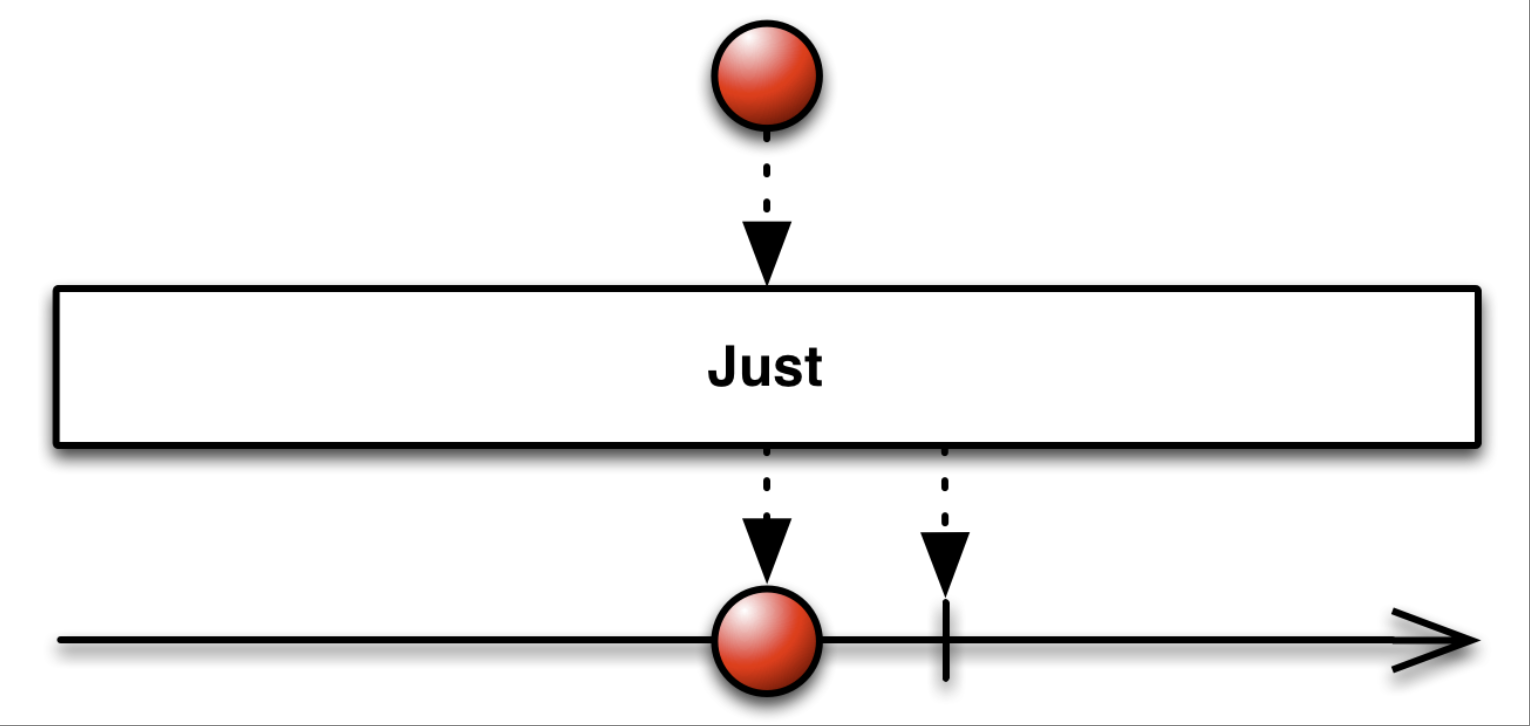
Creating observables
From

Creating observables
Interval

Creating observables
Timer

Creating observables
Range

Filtering observables
Filter
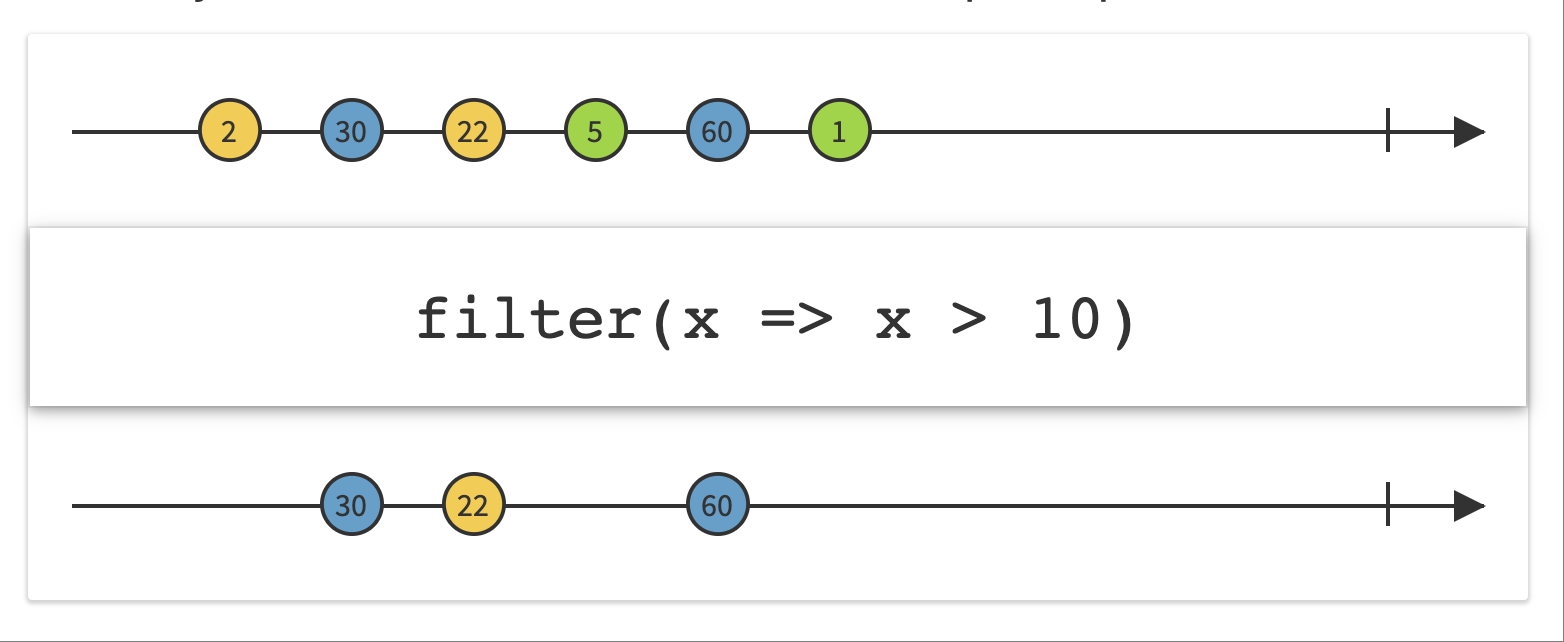
Filtering observables
Distinct
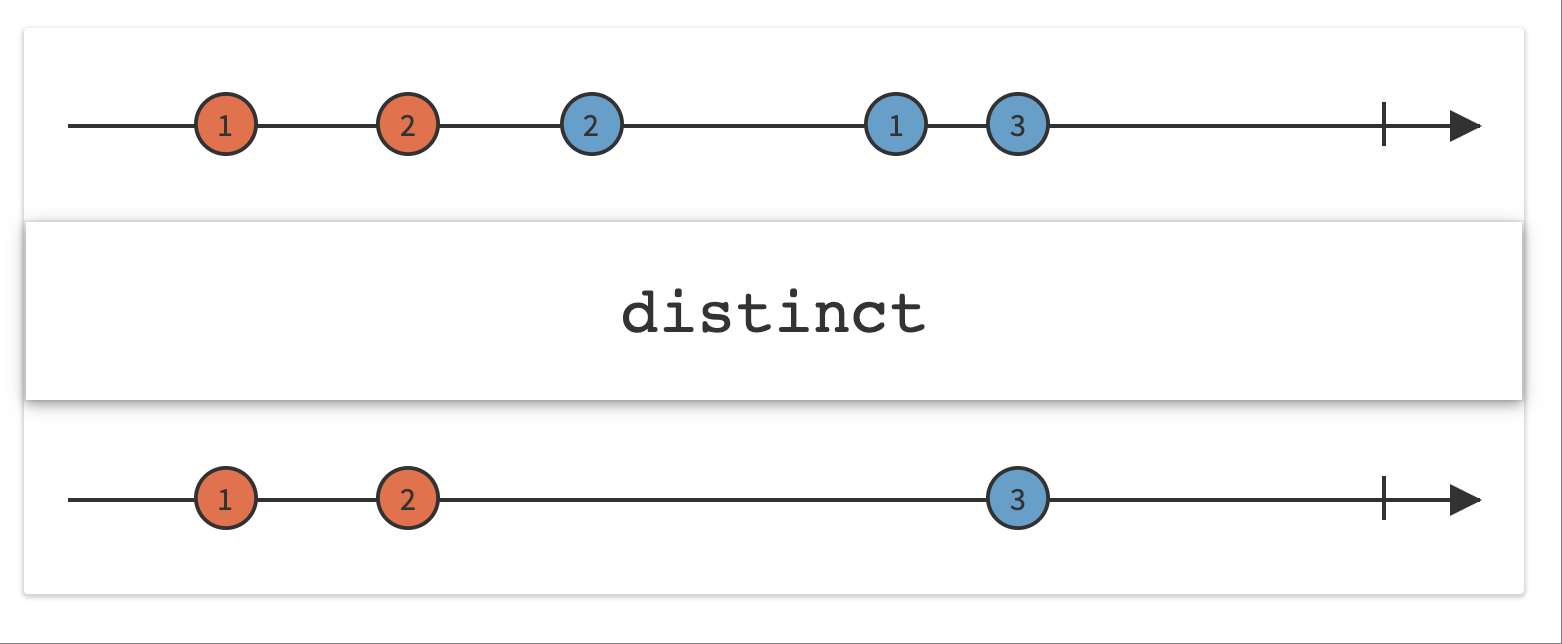
Filtering observables
Skip
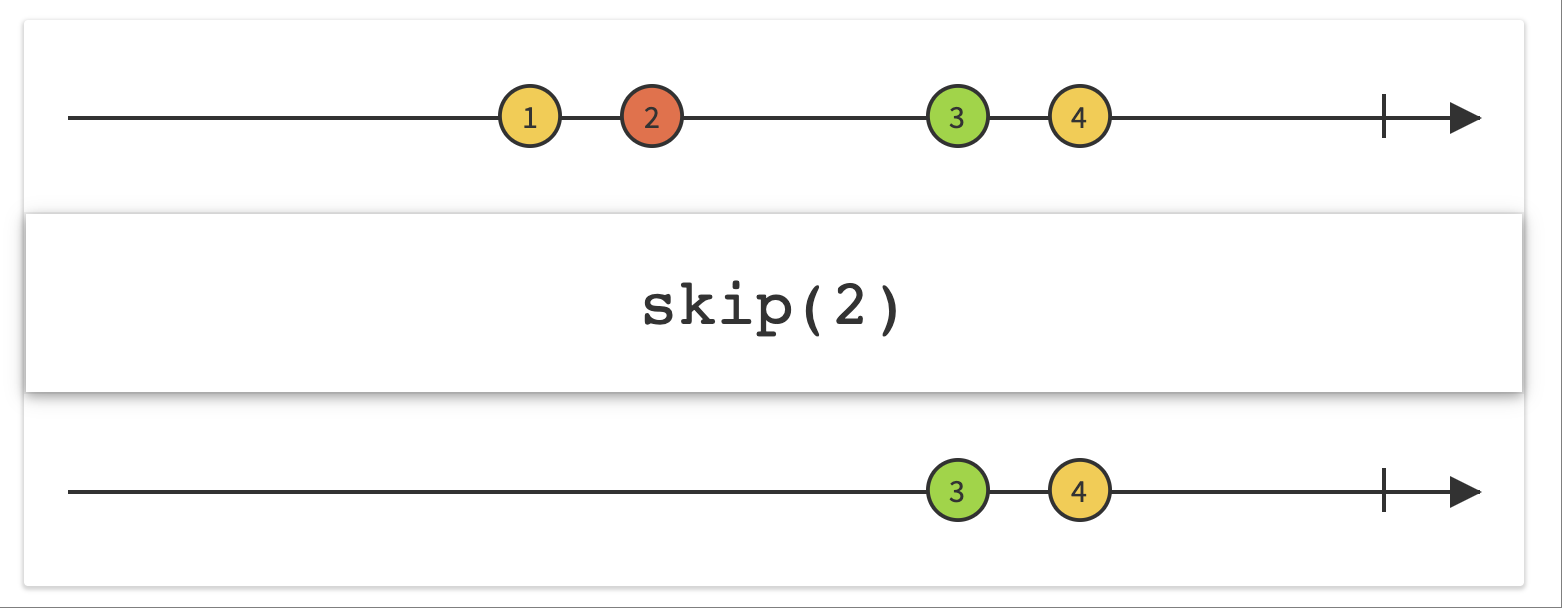
Filtering observables
Debounce
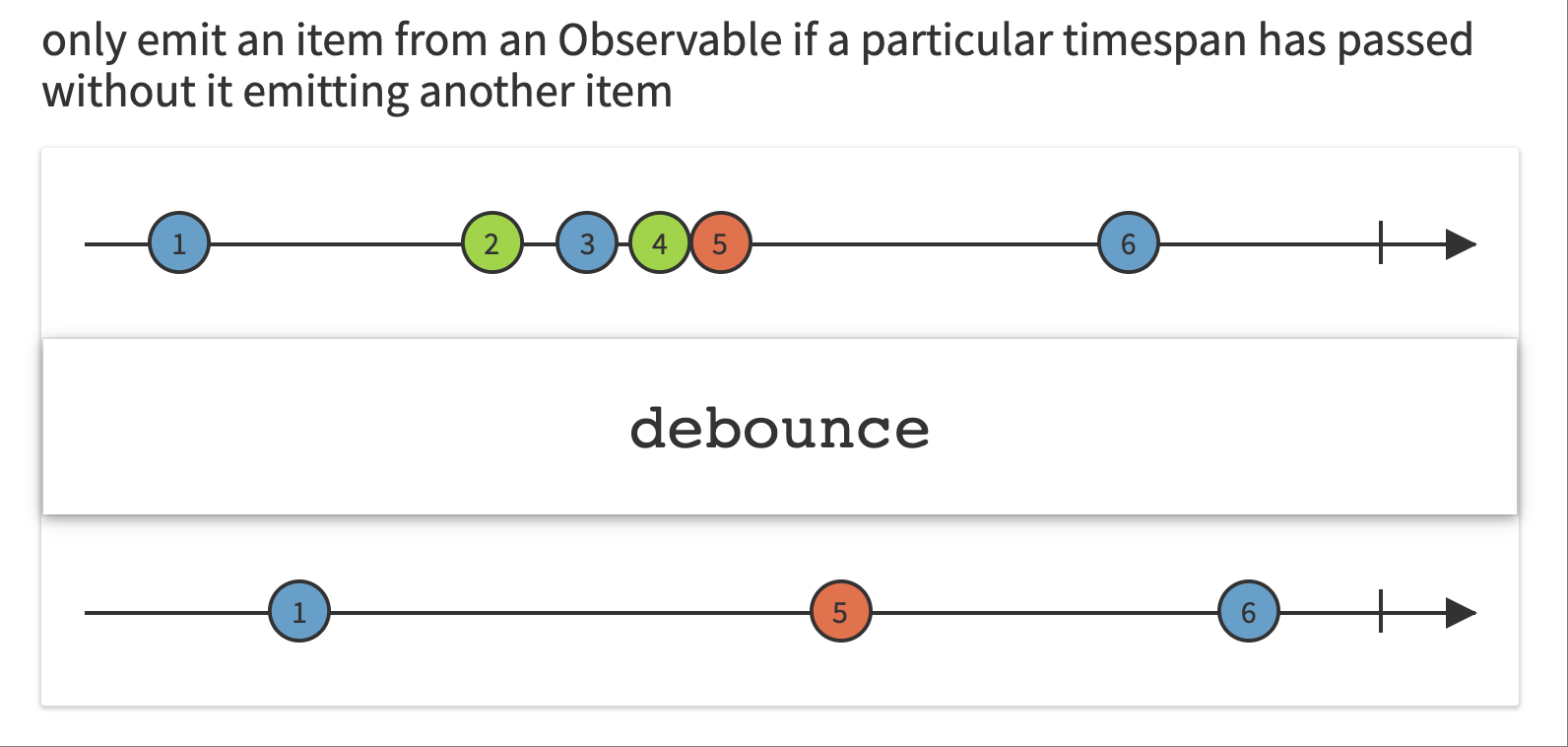
Transforming observables
Map
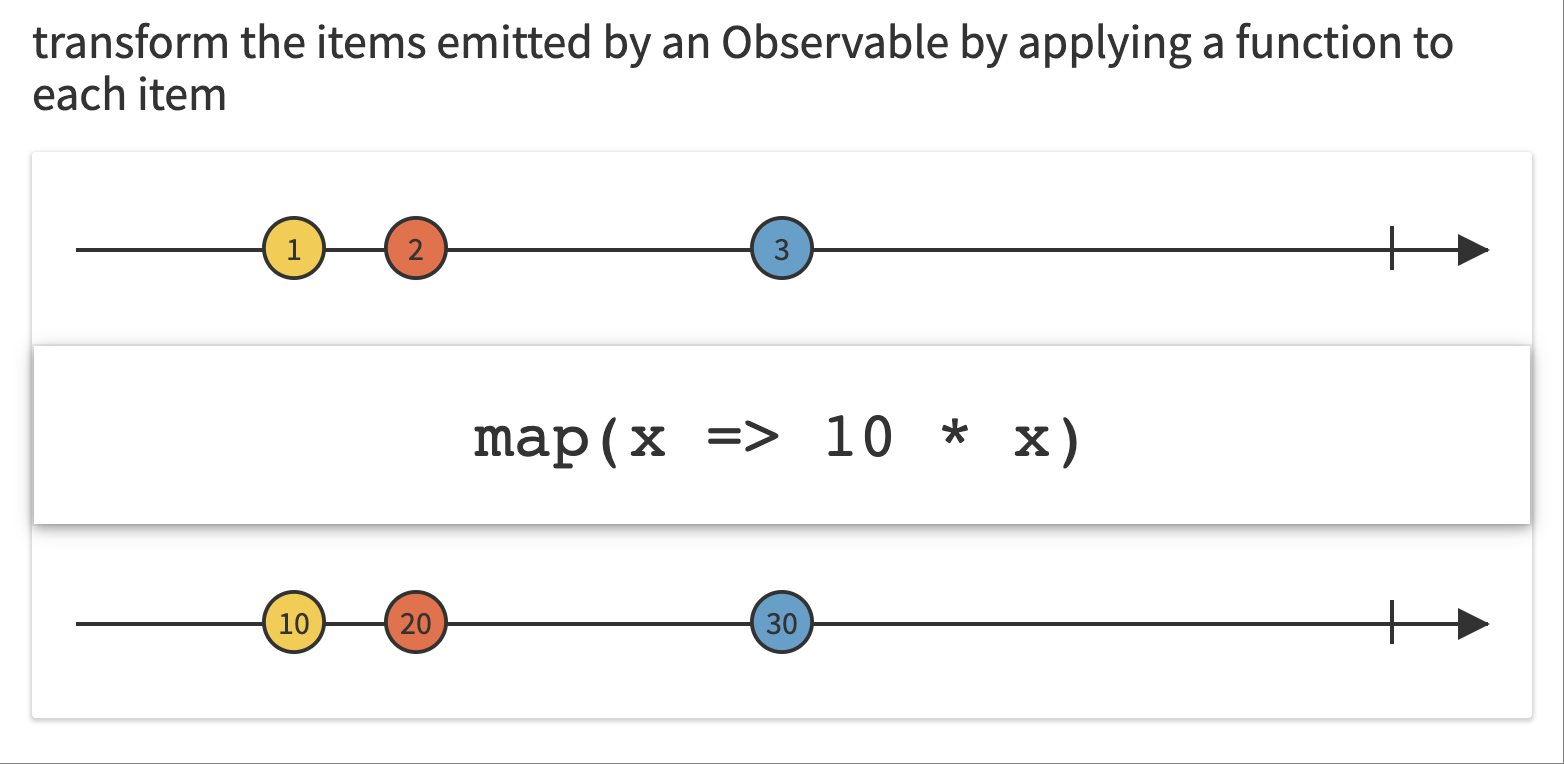
Transforming observables
Buffer
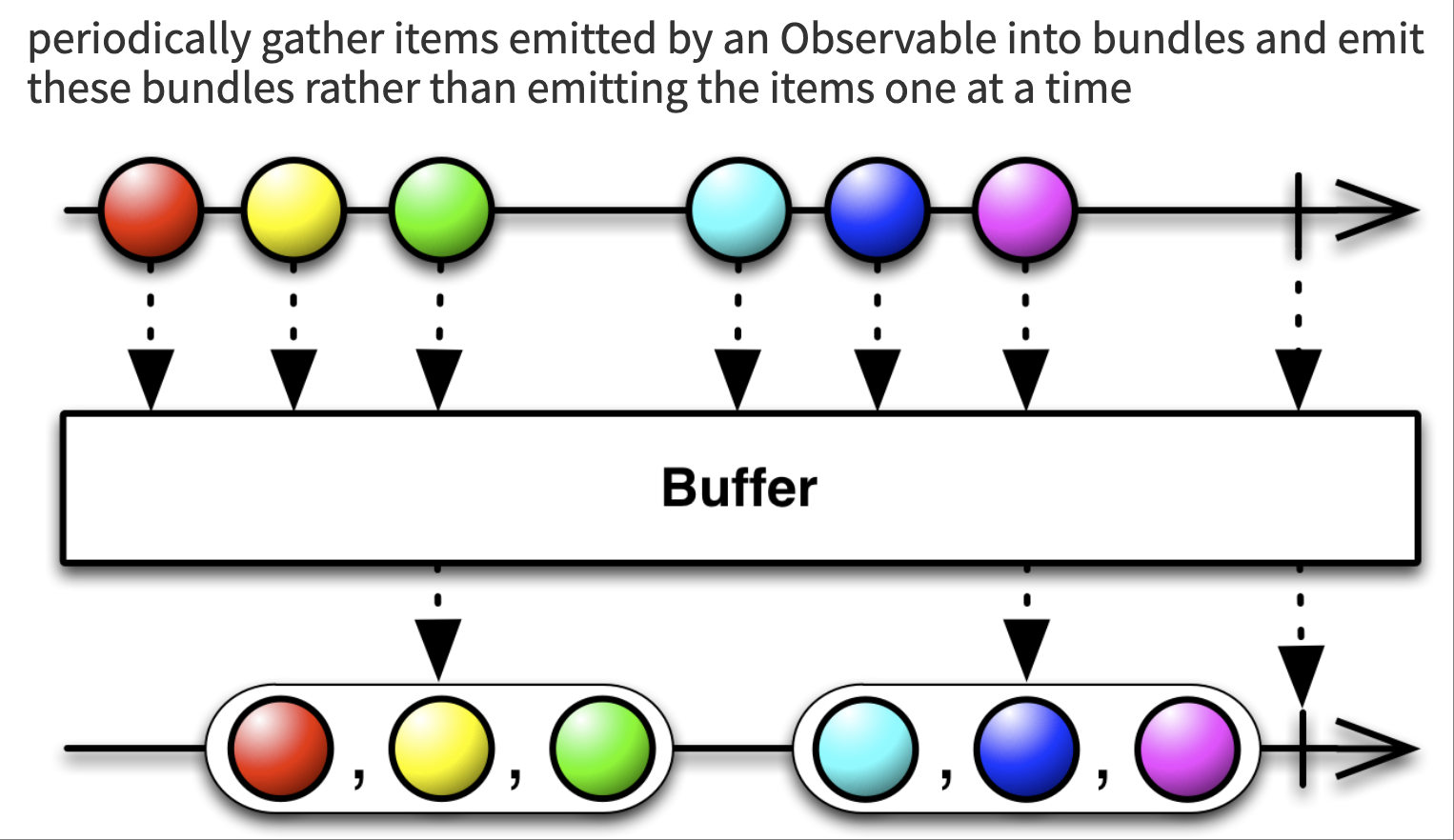
Transforming observables
FlatMap
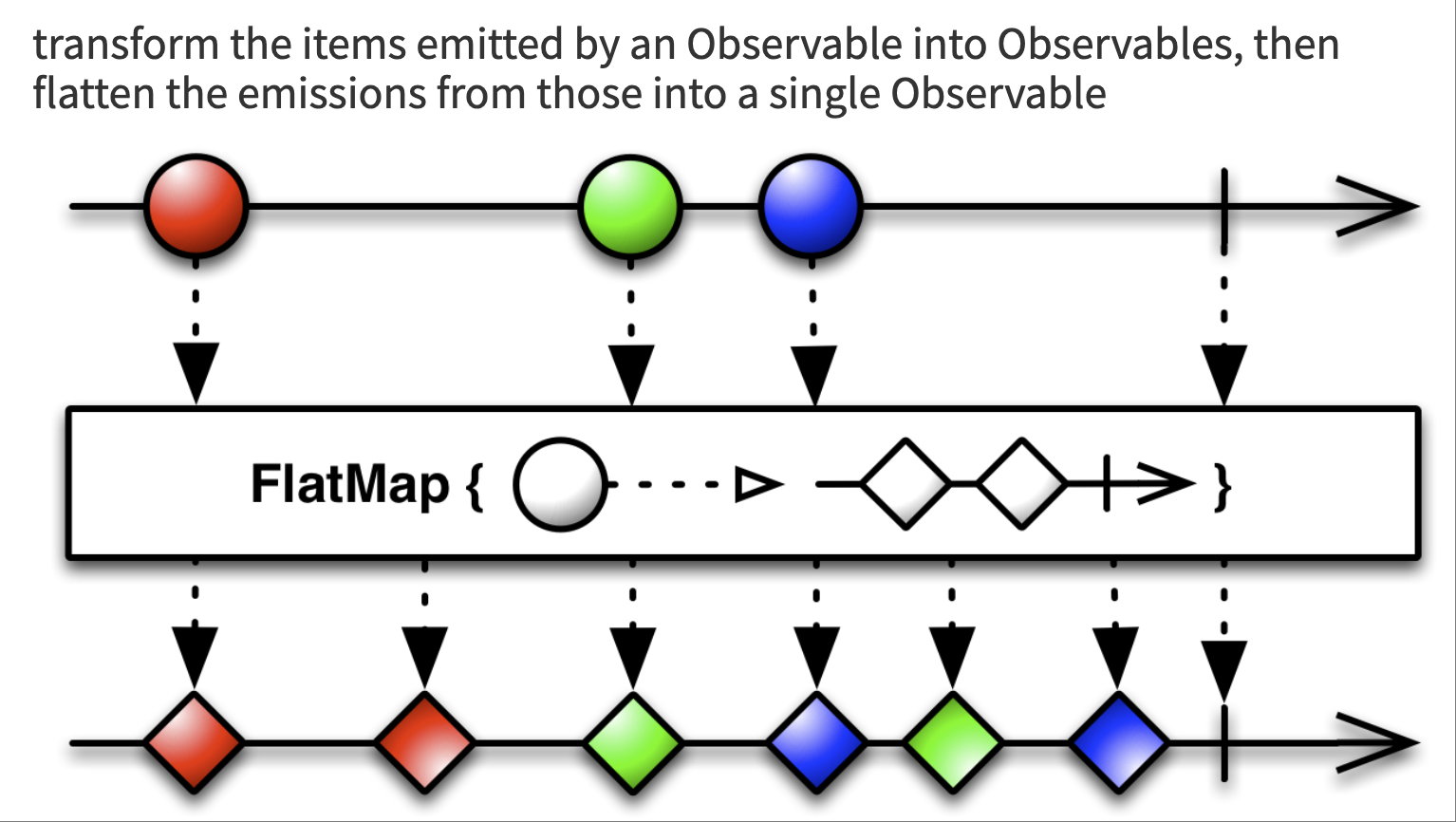
Combining observables
CombineLatest
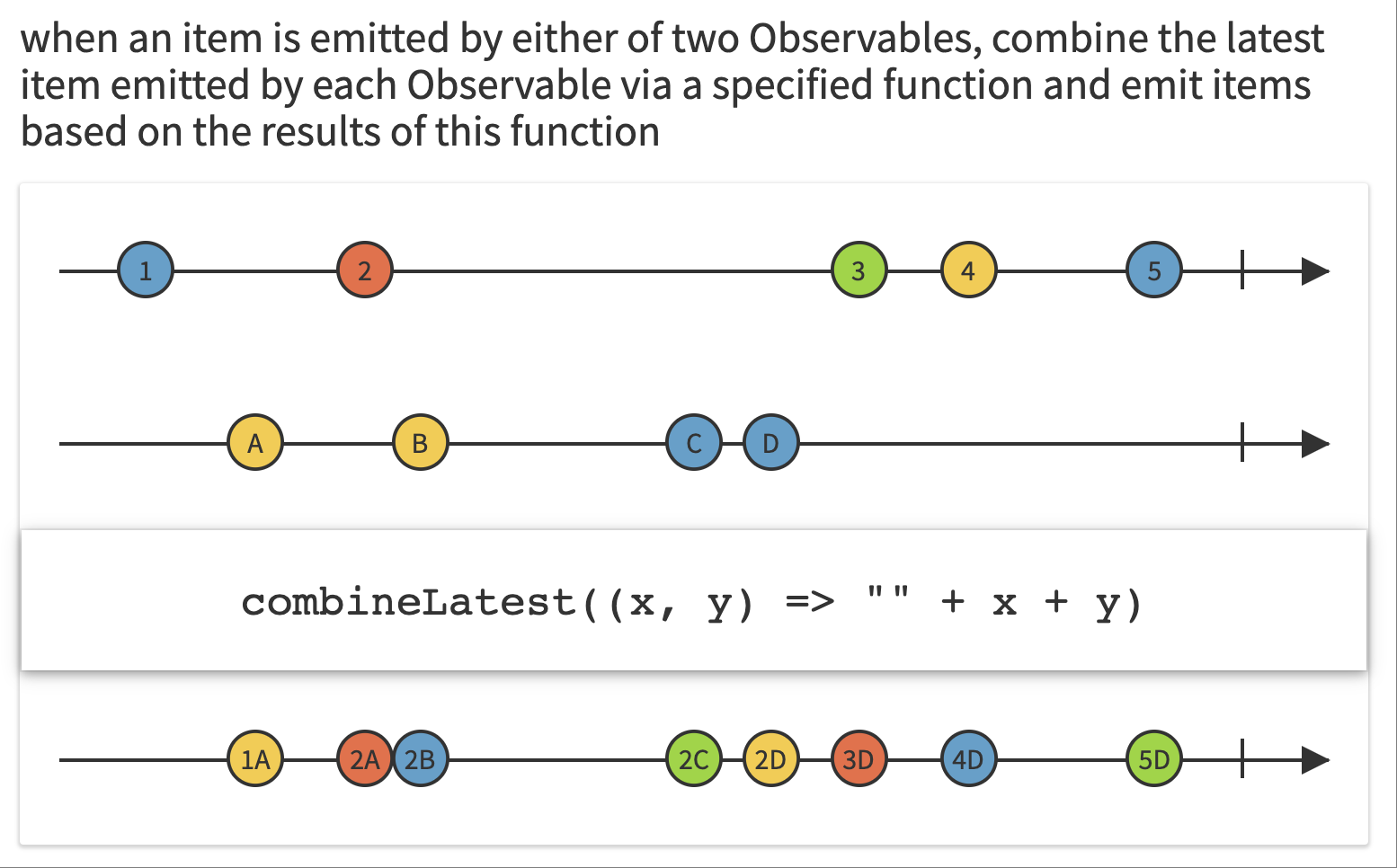
Combining observables
Merge
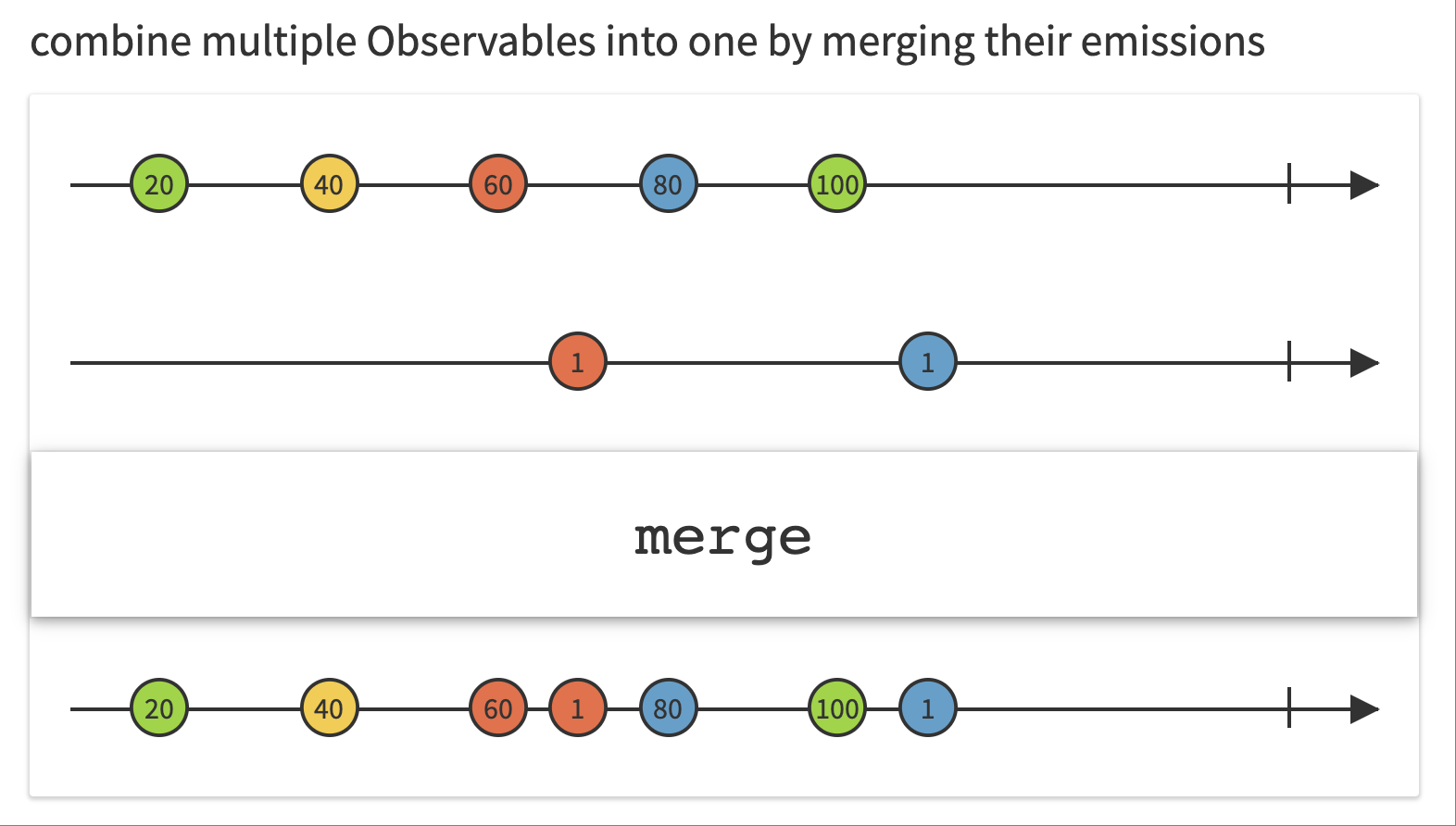
Combining observables
Zip
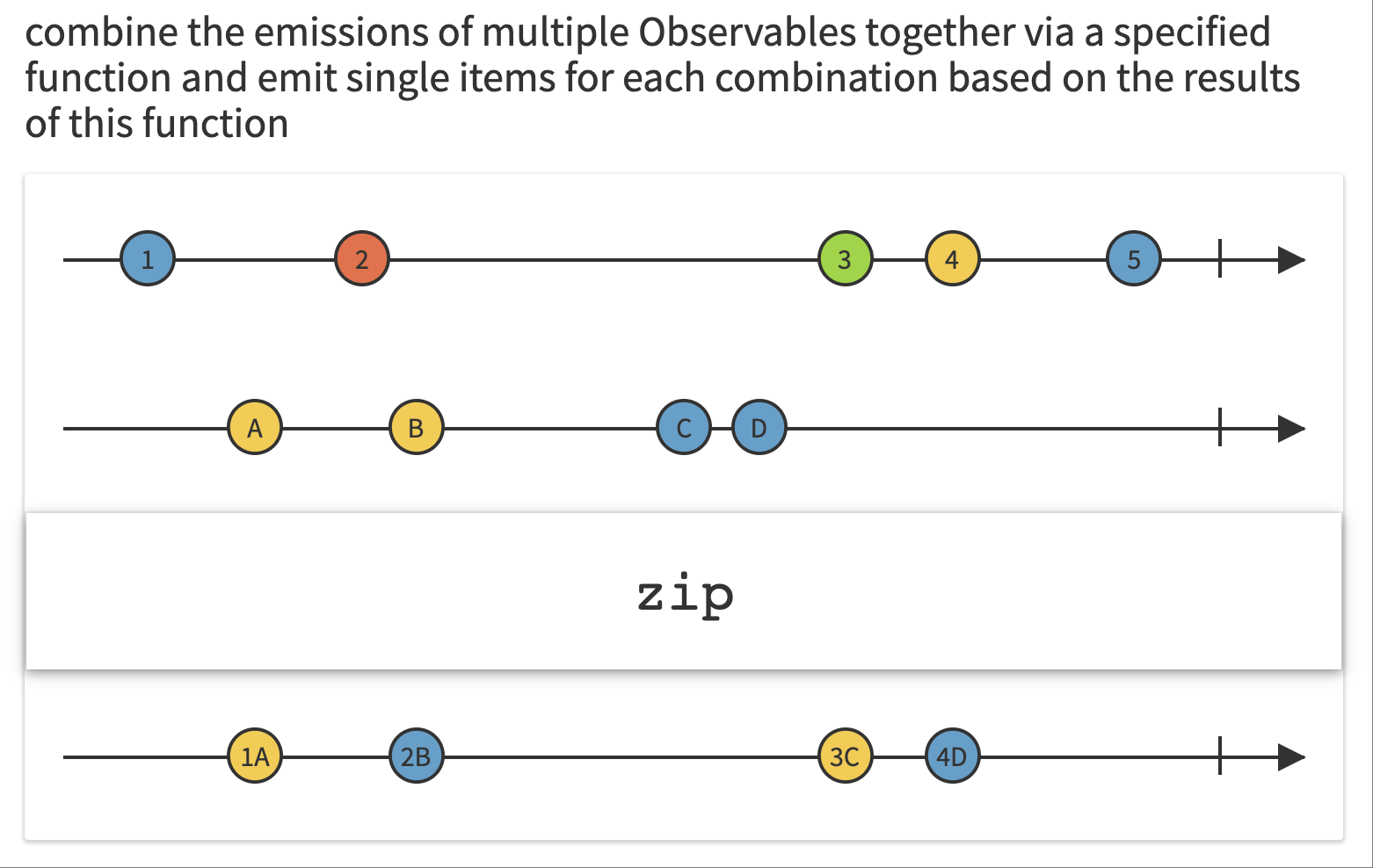
Combining observables
Concat

Other useful
Contains
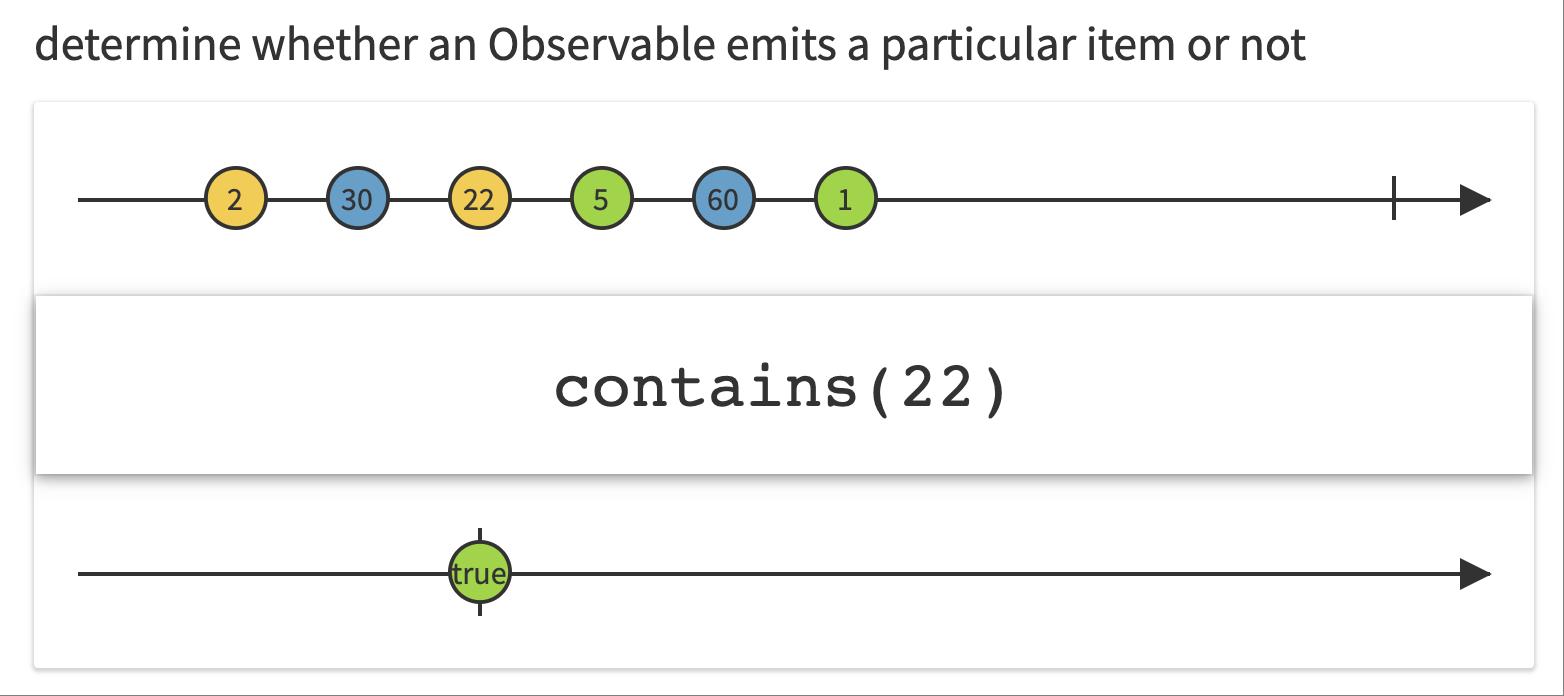
Other useful
Reduce
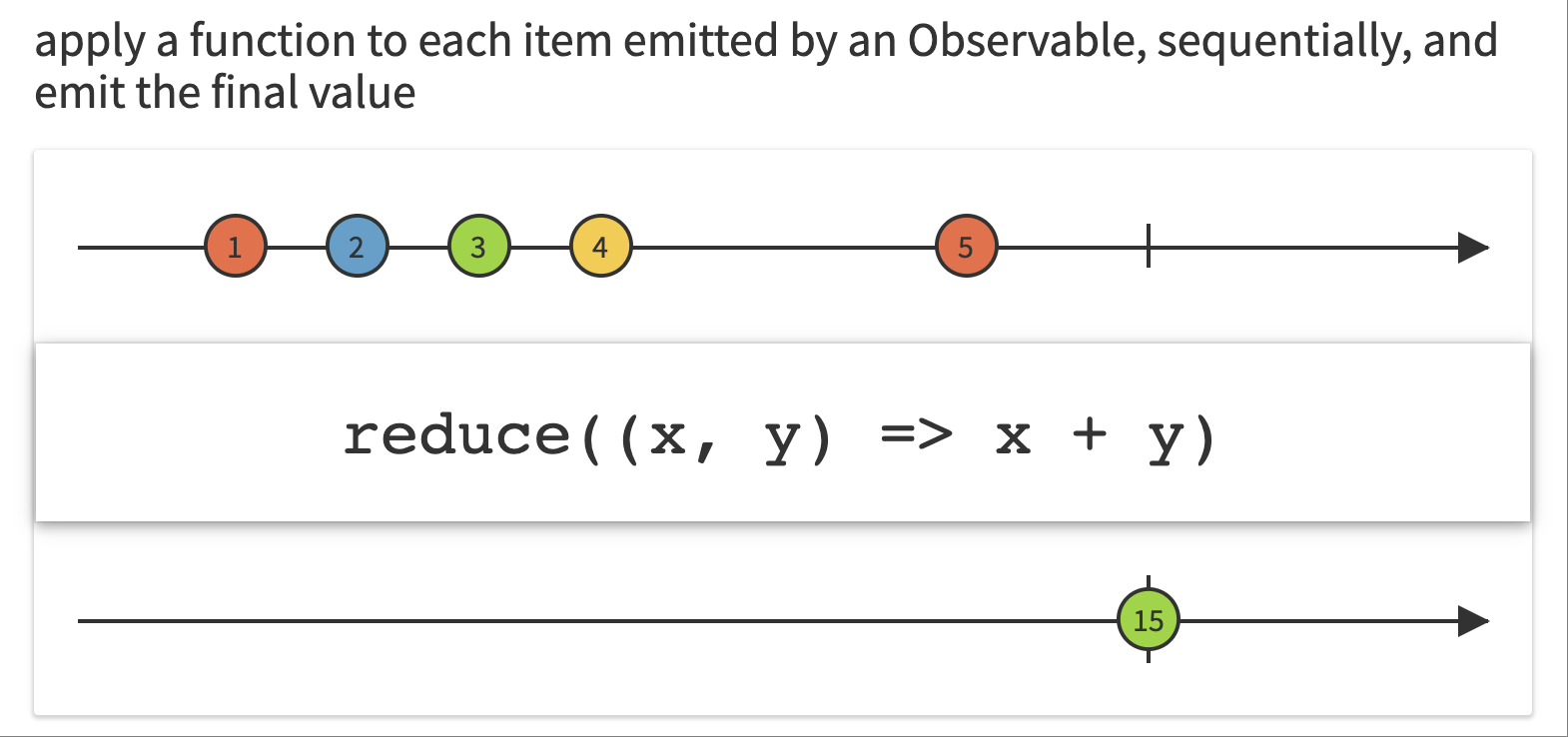
Subjects
PublishSubject
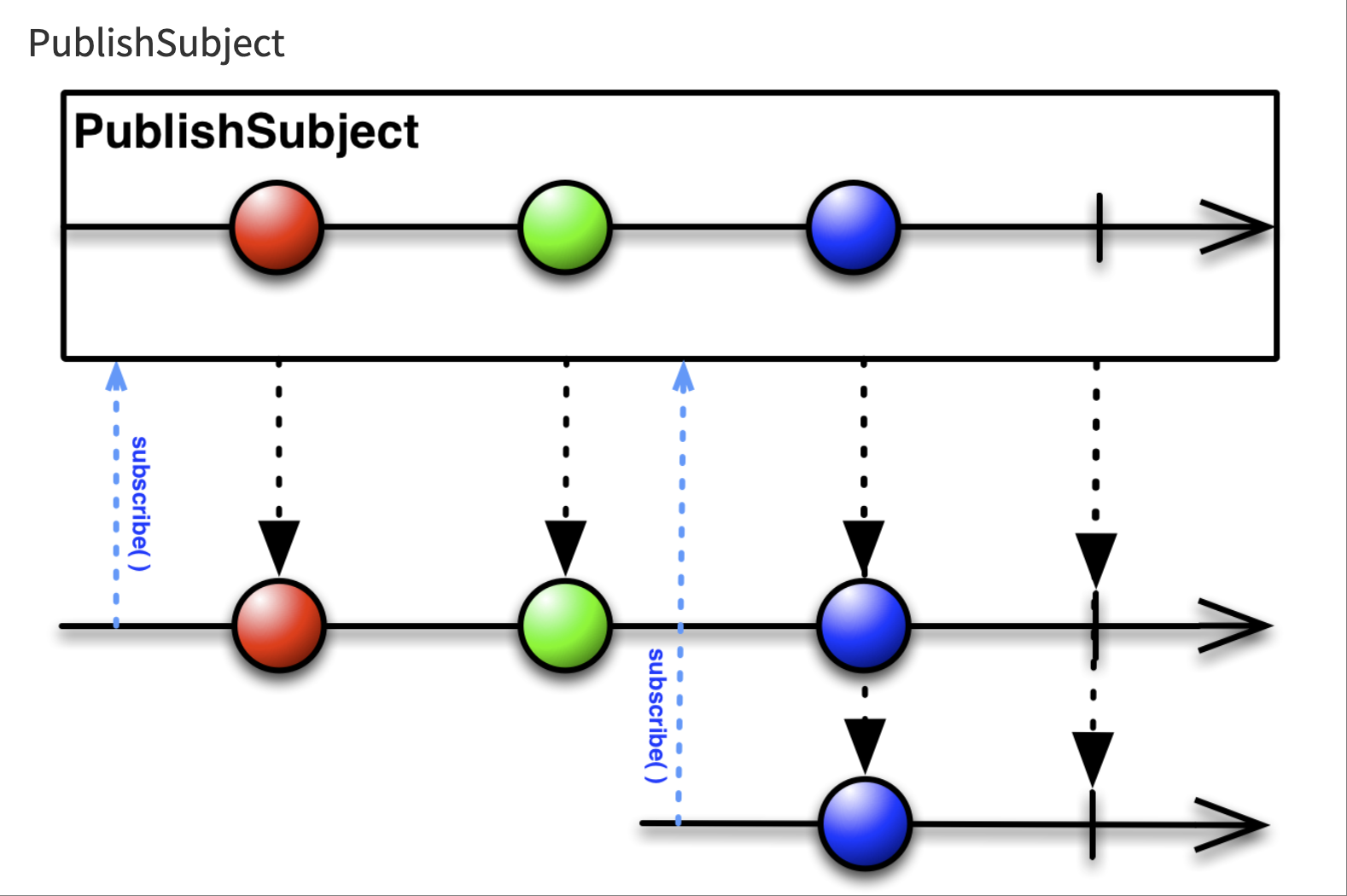
Subjects
BehaviourSubject
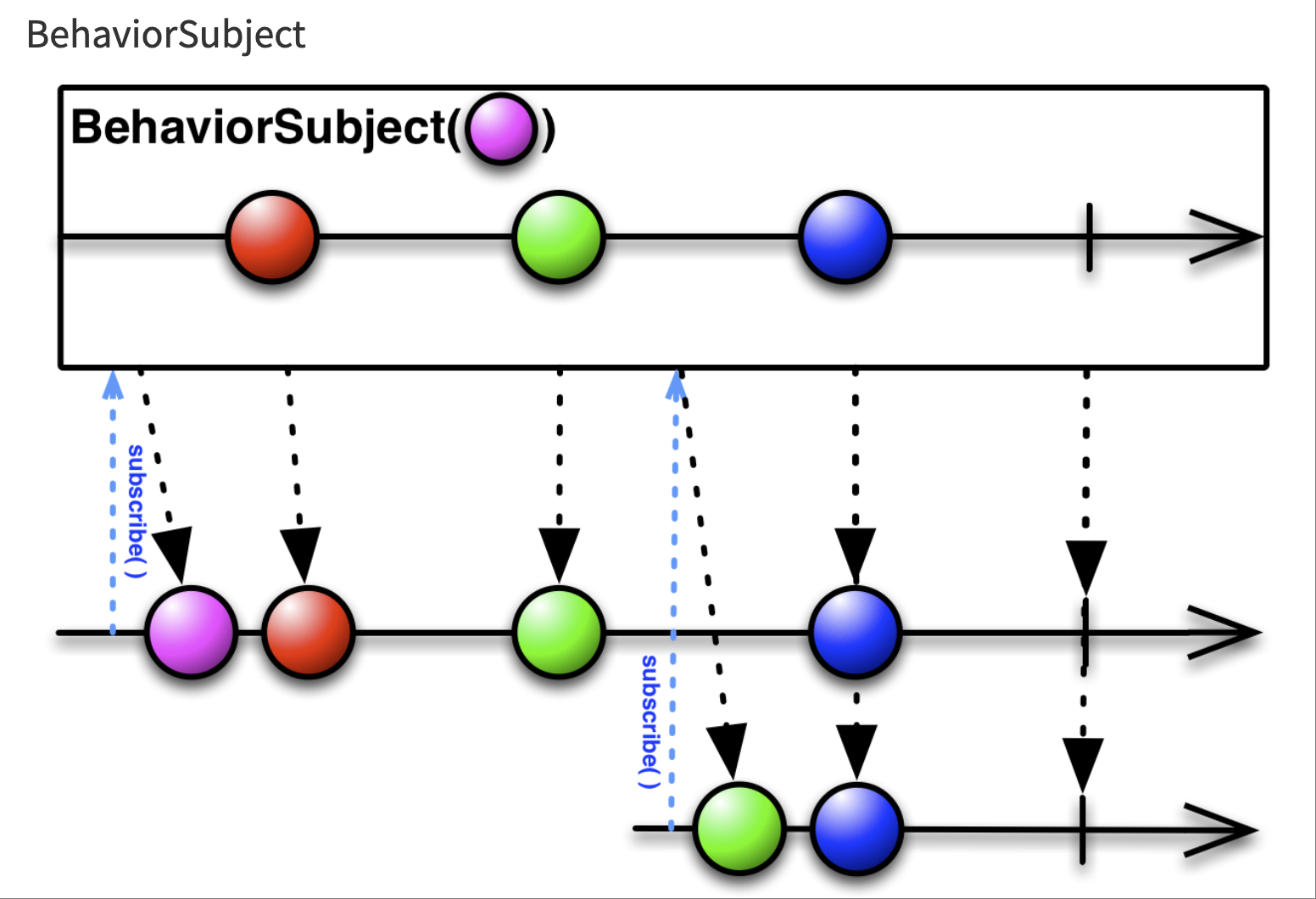
Subjects
ReplaySubject
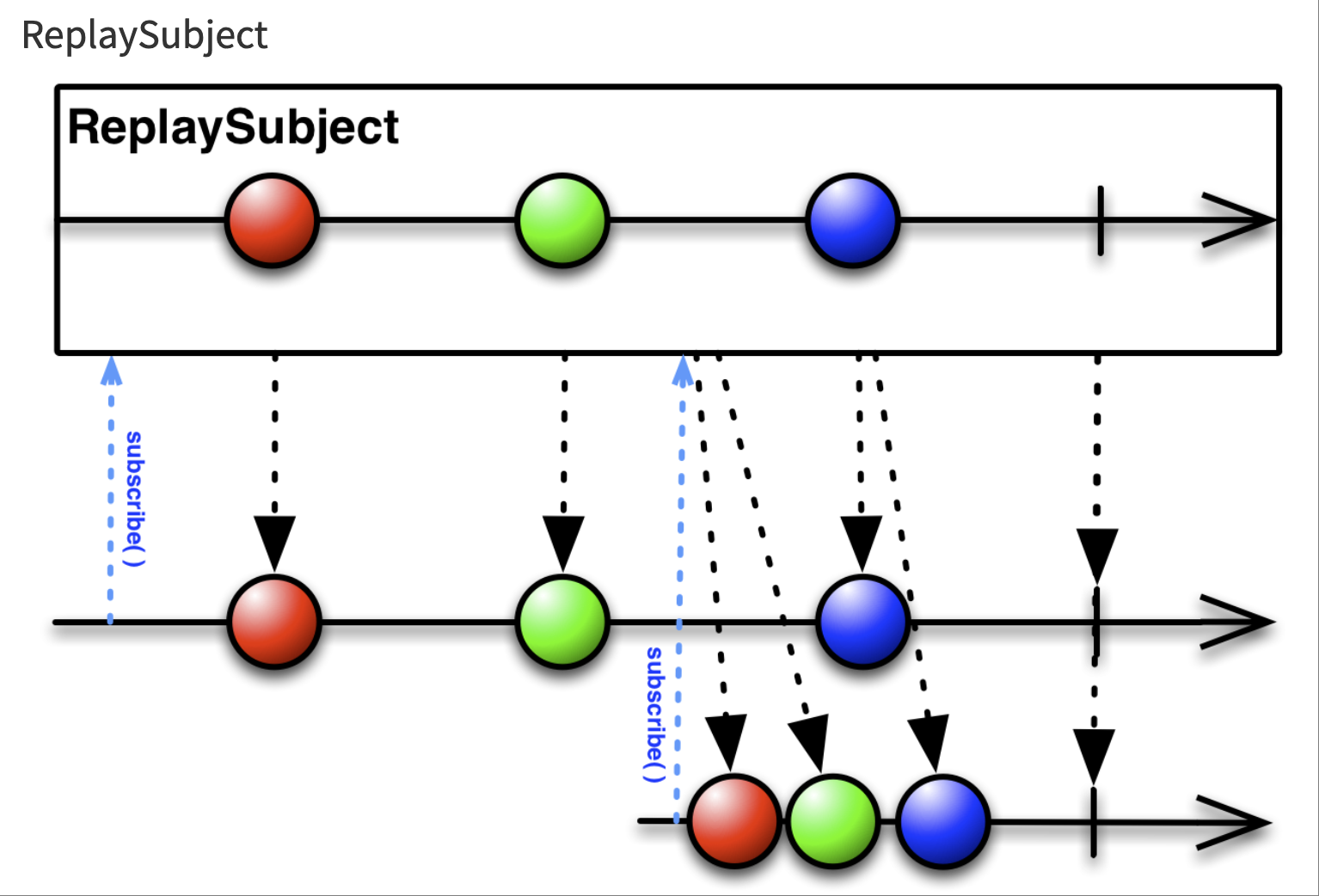
Subjects
AsyncSubject
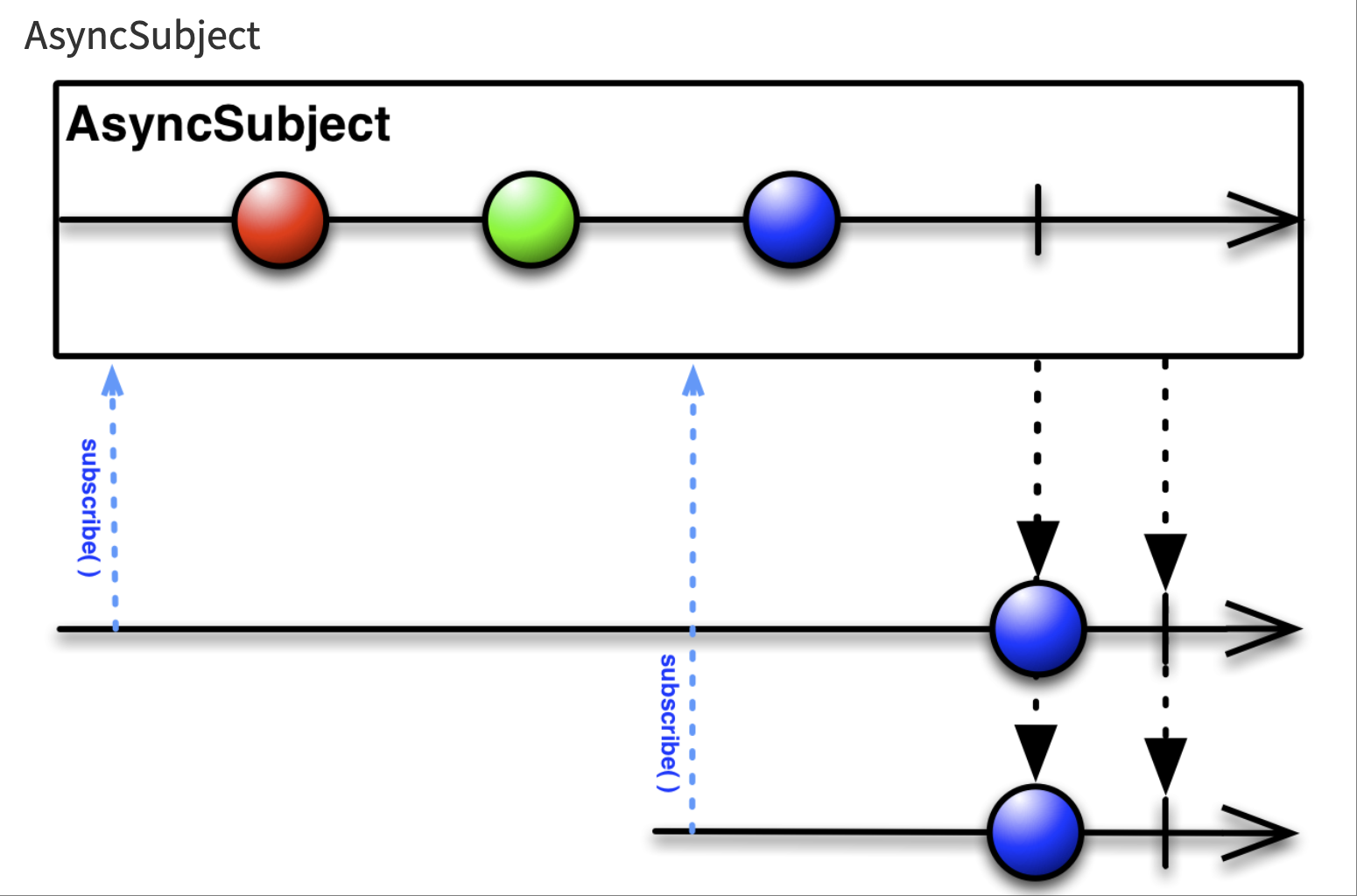
Backpreassure
Flowable
BackpressureStrategy
- buffer
- drop
- latest
Android deps
implementation "io.reactivex.rxjava3:rxjava:3.x.y"implementation "io.reactivex.rxjava3:rxkotlin:3.x.y"implementation "io.reactivex.rxjava3:rxandroid:3.x.y"implementation "com.jakewharton.rxbinding4:rxbinding-core:4.x.y"Simple examples
Throttle button click
val button = findViewById<Button>(R.id.my_button)button.clicks() .throttleLast(500, TimeUnit.MILLISECONDS) .observeOn(AndroidSchedulers.mainThread()) .subscribe { showToast("Millis ${System.currentTimeMillis()}") }Simple examples
Filter even numbers
listOf(1, 2, 3, 4, 5, 6, 7, 8, 9, 10) .toObservable() .filter { it % 2 == 0 } .subscribe { println(it) }Simple examples
Iterating with forEach()
Observable.just("some", "words", "to", "print") .forEach { println(it) }Simple examples
Group by
Observable.just(1, 2, 3, 4, 5) .groupBy { it % 2 == 0 } .subscribe { grouped -> grouped.toList().subscribe { integers -> println("$integers grouped.even: ${grouped.key}") } }Output
[1, 3, 5] grouped.even: false [2, 4] grouped.even: trueObservable.just(1, 2, 3, 4, 5) .groupBy { it % 2 == 0 } .flatMapSingle { grouped -> grouped.toList() } .subscribe { integers -> println(integers) }[1, 3, 5][2, 4]Simple examples
Take only the first N values emitted
listOf(1, 2, 3, 4, 5).toObservable() .take(3) .subscribe { println(it) }Take only last error or throw an error
listOf(1, 2, 3, 4, 5).toObservable() .lastOrError() .subscribe { result -> println("only last $result") }Only distinct elements
listOf(1, 1, 2, 2, 3, 4, 5, 5).toObservable() .distinct() .subscribe { println("$it") }Output
1, 2, 3, 4, 5Simple examples
Does not have to emit items of the same type as the source Observable
Observable.just("Some string") .map { it.hashCode() } .subscribe { println("hashCode: $it") }Output
hashCode: -1231765347FlatMap
Transform the items emitted by an Observable into Observables, then flatten the emissions from those into a single Observable
val scheduler = TestScheduler()listOf("a", "b", "c", "d", "e", "f") .toObservable() .flatMap { emittedString -> val randomLong = Random.nextLong(30) Observable.just("delayed emitted '$emittedString' to ${randomLong}s") .delay(randomLong, TimeUnit.SECONDS, scheduler) } .subscribe { string -> println(string) }scheduler.advanceTimeBy(1, TimeUnit.MINUTES)Output
delayed emitted 'b' to 3sdelayed emitted 'a' to 7sdelayed emitted 'd' to 15sdelayed emitted 'f' to 16sdelayed emitted 'e' to 17sdelayed emitted 'c' to 26sConcatMap
Like FlatMap but ordered
val scheduler = TestScheduler()listOf("a", "b", "c", "d", "e", "f") .toObservable() .concatMap { emittedString -> val randomLong = Random.nextLong(10) Observable.just("delayed emitted '$emittedString' to ${randomLong}s") .delay(randomLong, TimeUnit.SECONDS, scheduler) } .subscribe { string -> println(string) }scheduler.advanceTimeBy(10, TimeUnit.SECONDS)println("break")scheduler.advanceTimeBy(20, TimeUnit.SECONDS)Output
delayed emitted 'a' to 3sdelayed emitted 'b' to 2sdelayed emitted 'c' to 1sbreakdelayed emitted 'd' to 5sdelayed emitted 'e' to 5sdelayed emitted 'f' to 1sFilter & Debounce
Avoid accidental double clicks with debounce. Server search EditText for example.
val edt = findViewById<EditText>(R.id.my_edt)edt.textChanges() .skipInitialValue() .filter { it.length > 3 } .debounce(500, TimeUnit.MILLISECONDS) .subscribe { Log.d(TAG, "$it") }Output
2021-04-16 20:11:51.776: sea2021-04-16 20:11:53.152: sear2021-04-16 20:11:54.118: searc2021-04-16 20:11:55.088: search2021-04-16 20:12:01.947: search with de2021-04-16 20:12:03.200: search with debounceLogin form
val loginObs = edtLogin.textChanges()val passwordObs = edtPassword.textChanges()btnSubmit.isEnabled = falseObservable.combineLatest(loginObs, passwordObs, { loginObs, passwordObs -> val loginCheck = loginObs.length > 3 val passwordCheck = passwordObs.length > 3 loginCheck && passwordCheck}).subscribe { enabled -> btnSubmit.isEnabled = enabled }Thread safety
val textView = findViewById<TextView>(R.id.my_tv)listOf(1, 2, 3, 4, 5, 6, 7, 8, 9, 10) .toObservable() .flatMap { number -> heavyCalculation(number) } // all the computations will happen in a background thread .subscribeOn(Schedulers.computation()) // the result subscription will happen in the UI thread .observeOn(AndroidSchedulers.mainThread()) // do the calcs for each item and return it to observer .subscribe { result -> textView.text = result.toString() }Persist data to the database
val users: List<User> = listOf(user1, user2, user3)users.toObservable() .concatMapCompletable { user -> saveToDb(user) } .subscribeOn(Schedulers.io()) .observeOn(AndroidSchedulers.mainThread()) .subscribe()RxJava and Android real examples
Exponential backoff
https://medium.com/over-engineering/rxify-exponential-backoff-on-retry-48bb66912391
private fun exportAt(scale: Double): Bitmap { println("export image image at scale $scale") return if (scale > 0.24) { Bitmap(ByteArray(0)) } else { throw RuntimeException("OutOfMemory") }}sealed class Result { data class Success(val double: Double) : Result() data class Failed(val error: Throwable) : Result()}RxJava and Android real examples
Exponential backoff
https://medium.com/over-engineering/rxify-exponential-backoff-on-retry-48bb66912391
private fun exportProjectWithRetry(): Single<Result> { return Observable.range(0, 5) .map { input -> 1.0 / (2.0.pow(input)) } .concatMapSingle { scale -> exportAt(scale) .map<Result> { Result.Success(scale) } .onErrorReturn { Result.Failed(it) } } .takeUntil { it is Result.Success } .lastOrError()}RxJava and Android real examples
Exponential backoff
https://medium.com/over-engineering/rxify-exponential-backoff-on-retry-48bb66912391
exportProjectWithRetry().subscribe { result -> when (result) { is Result.Failed -> println("success") is Result.Success -> println("failure") }}Output
exportAt 1.0exportAt 0.5exportAt 0.25exportAt 0.125successSome more examples
Detecting and testing stalled streams
class SomeClass { void someMethod() { Flowable<String> events = /* some stream */; Flowable<String> eventsWithPings = events .mergeWith(events .debounce(1, SECONDS) .flatMap(x1 -> Flowable .interval(0, 1, SECONDS) .map(e -> "PING") .takeUntil(events) )); }}class SomeClass { void someMethod() { Flowable .timer(1, SECONDS) .flatMapCompletable(i -> doStuffAsync()) .repeat() .subscribe(); }}Some more examples
My real life example
class SomeClass { @Override public Completable send( String eventCode, ChatIds chatIds, long cid, String text ) { return serviceCommentCacheLoader.loadChat(chatIds) .flatMapCompletable(chat -> refreshForward(chat.getId(), eventCode, chatIds, new AtomicBoolean())) .observeOn(schedulers.networkIO()) .andThen(Single.just(mapToRequestJson(chatIds, cid, text))) .flatMap(commentRequestJson -> api.comment(eventCode, commentRequestJson)) .map(this::onCommentApiResponse) .observeOn(schedulers.diskIO()) .map(this::updateMessage) .doOnSuccess(message -> // чтобы при kill жило serviceCommentCacheLoader.loadMessages(message.getId()) ).doOnSuccess(message -> messageCache.add(message.getChatId(), Collections.singletonList(message)) ).ignoreElement(); }}Performance
v1 vs v2 vs v3
Tomcat vs Rx performance measures
Applying Reactive Programming with RxJava , Ben Christensen
Performance
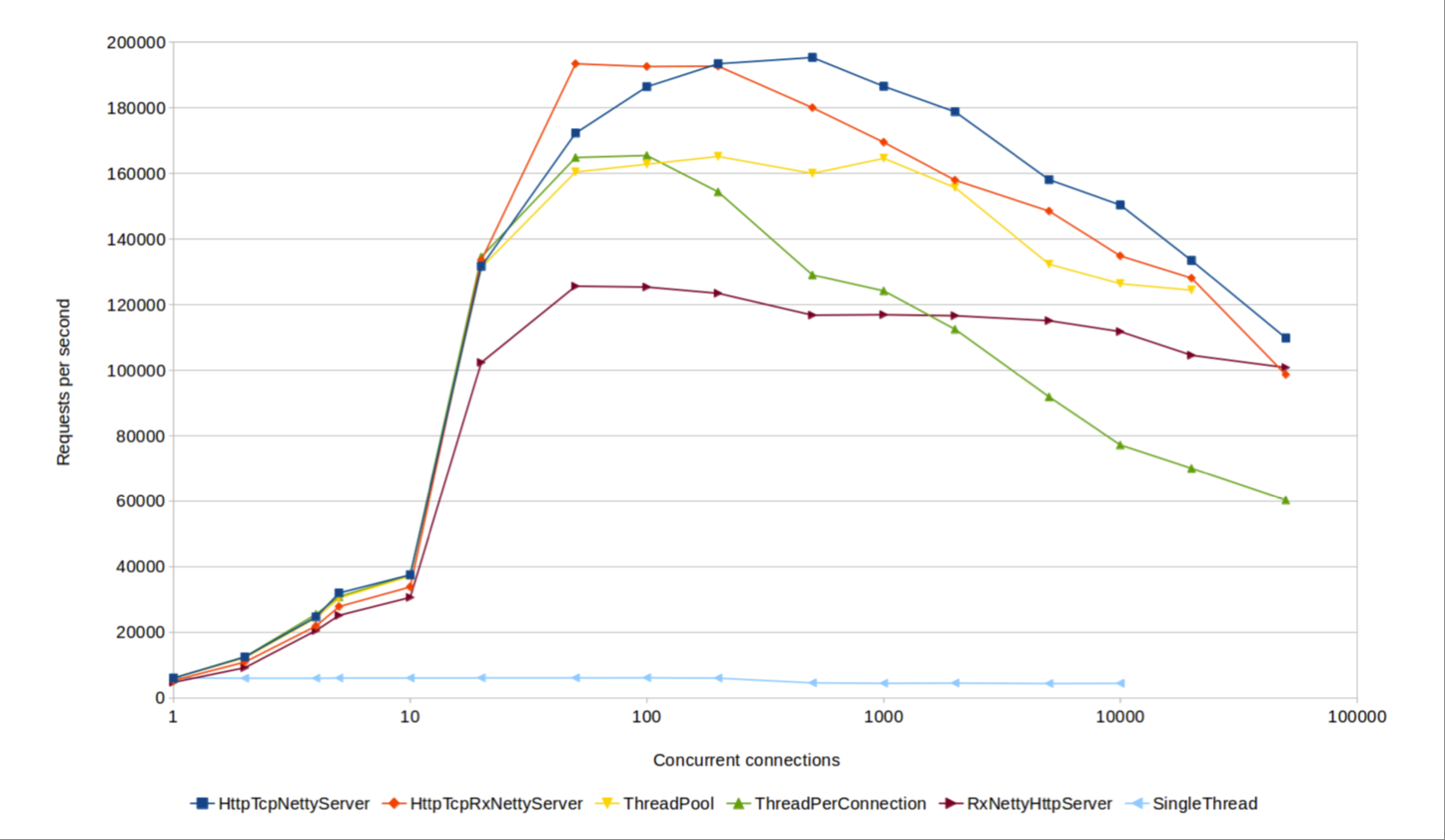
Performance
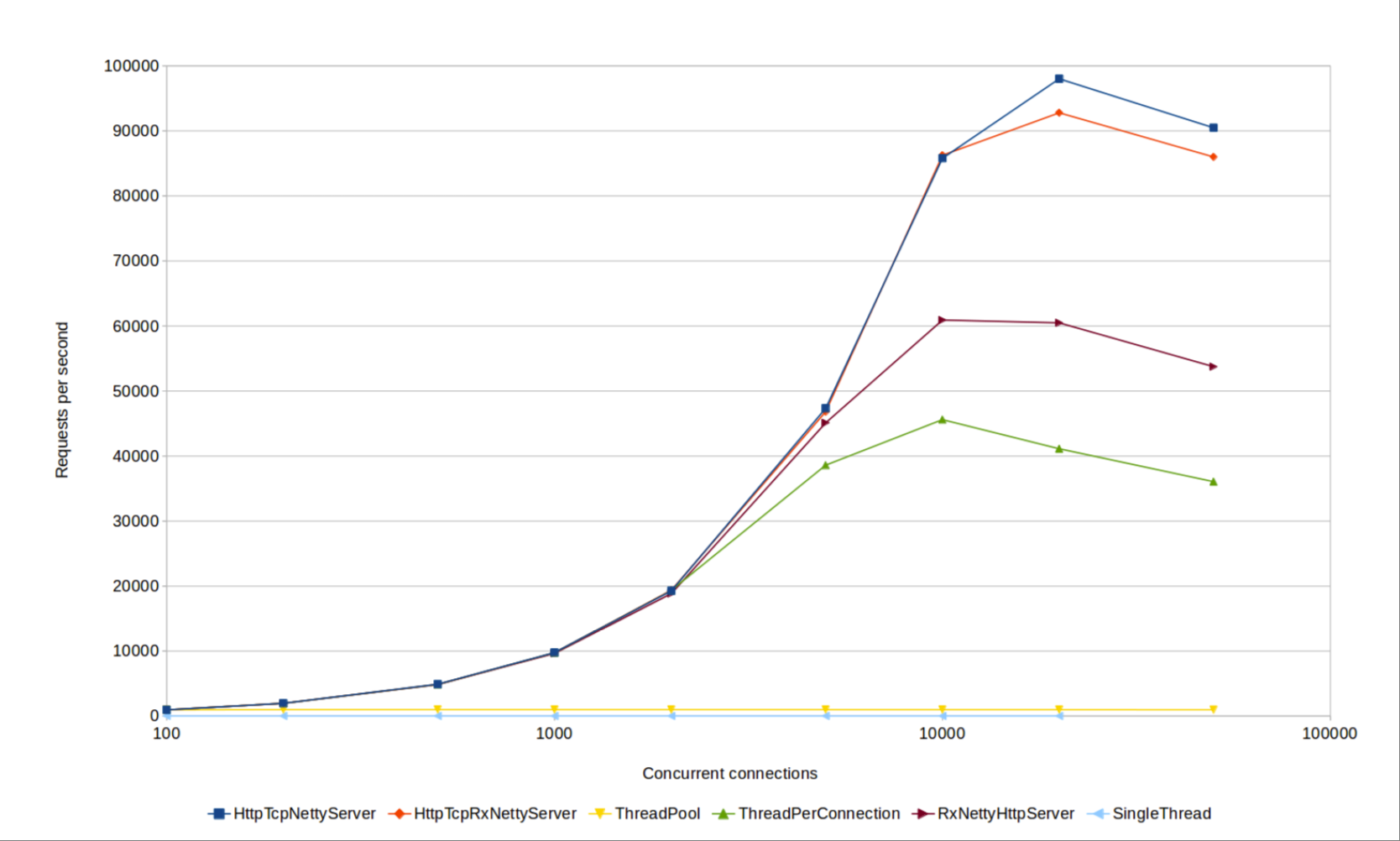
Performance
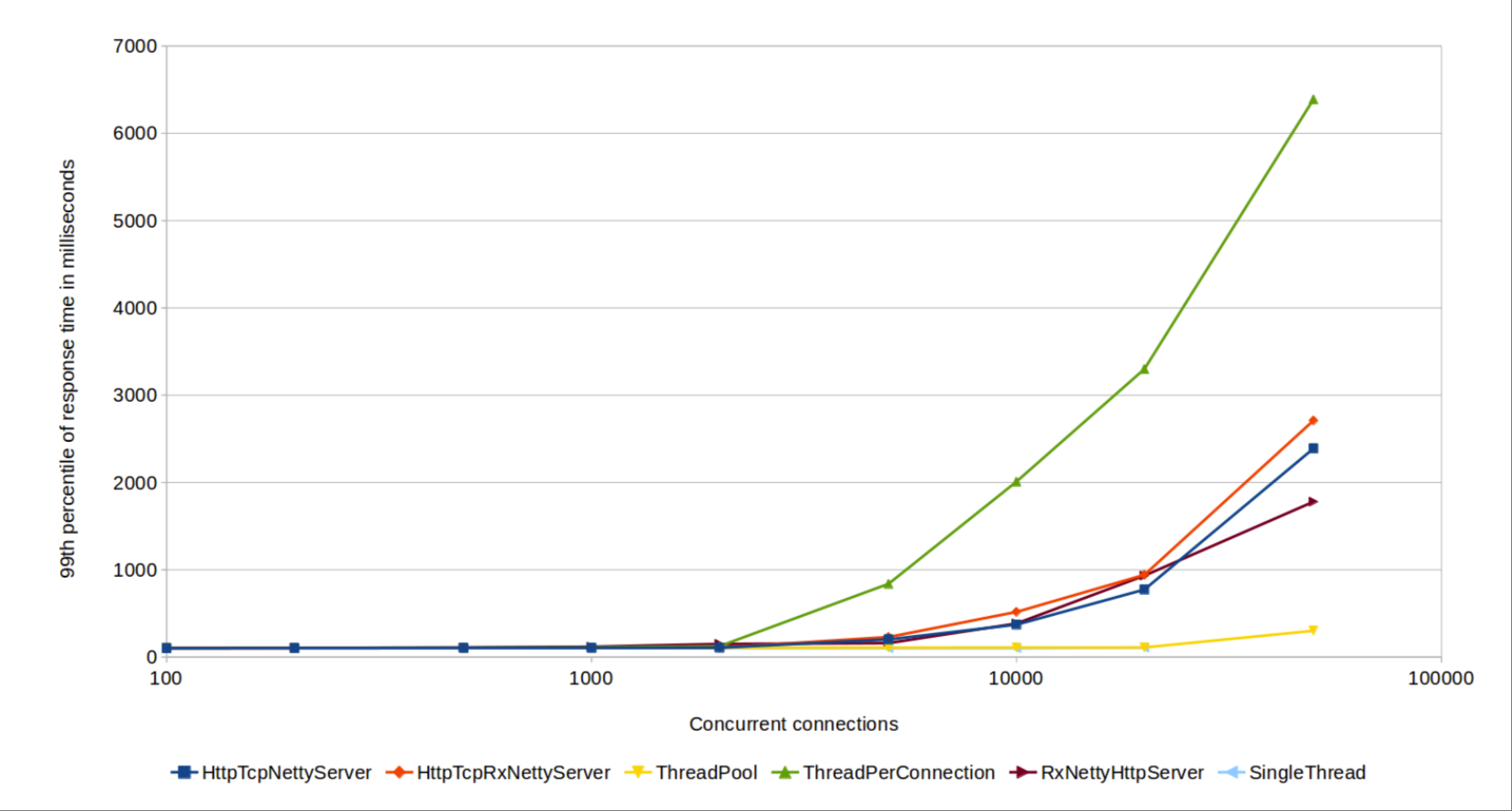
Cons: traditional vs reactive costs
Netflix point by Tomasz Nurkiewicz (backend)
Cons: traditional vs reactive costs

Cons: traditional vs reactive costs
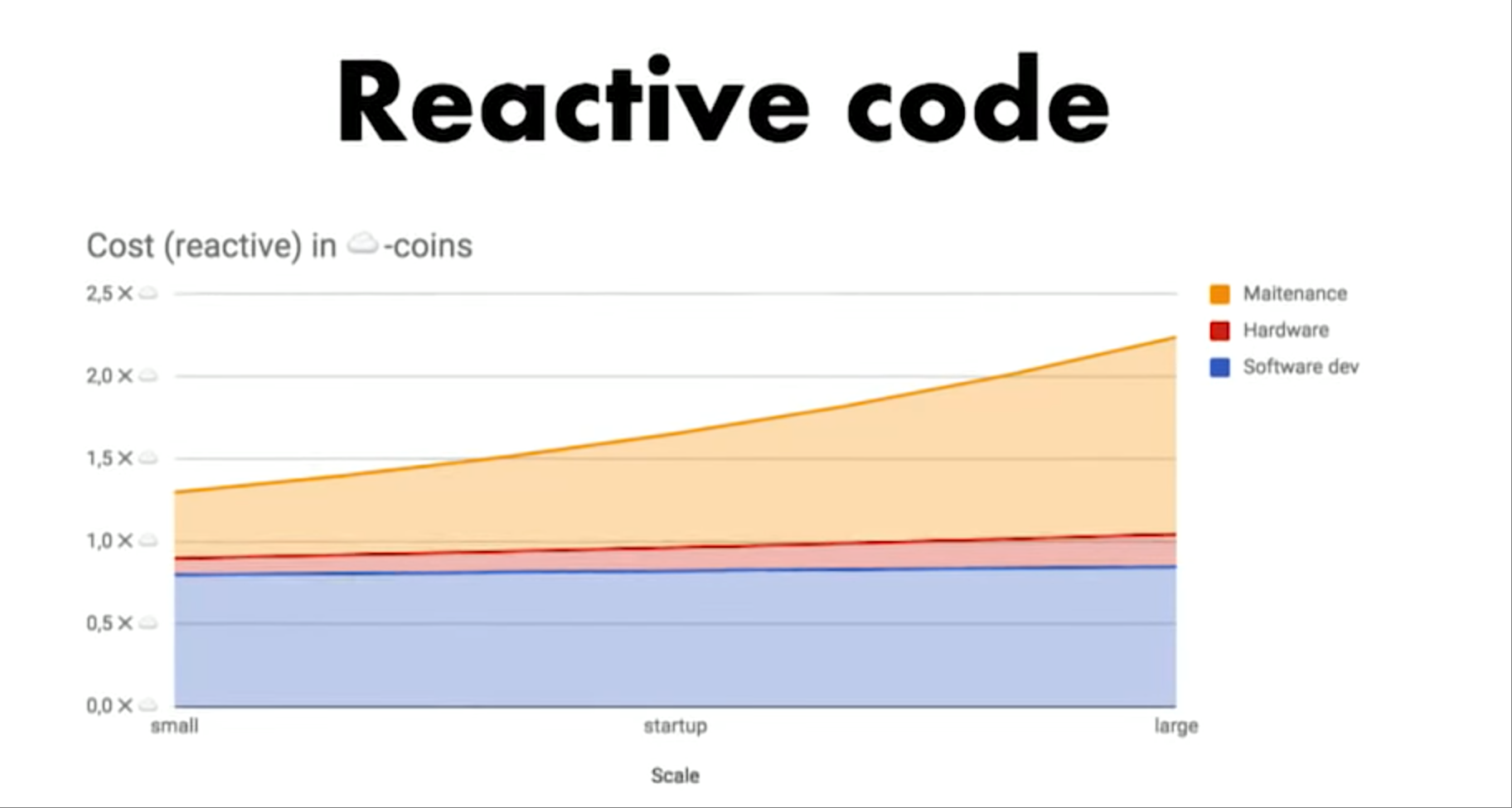
Cons: traditional vs reactive costs

Cons: traditional vs reactive costs
Netflix point
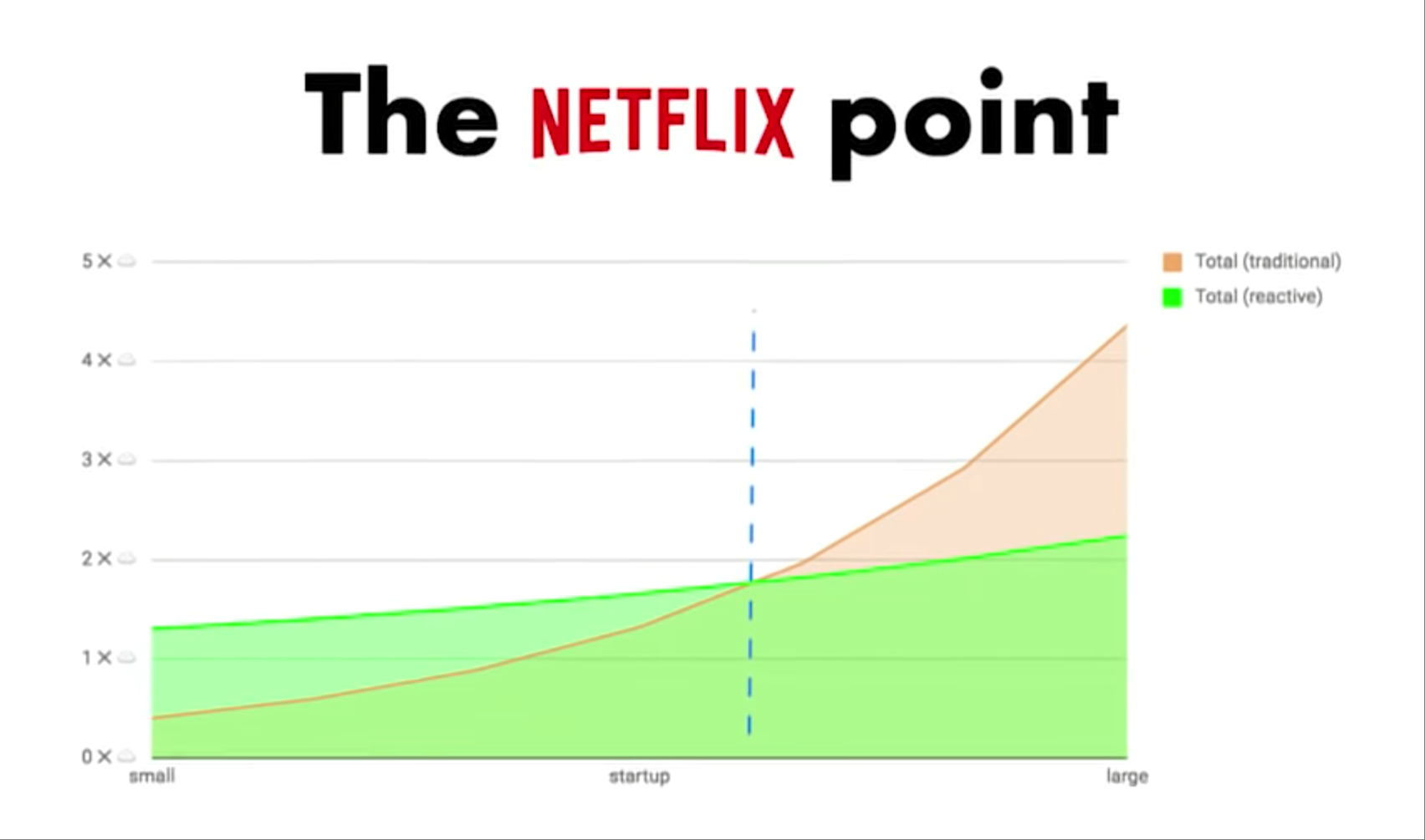
Cons: traditional vs reactive costs
Netflix point
Little's Law
L = λ ⋅ W
Tomcat, 100 threads (L), 100 ms/request (W), λ - ?
λ = 1k requests/second (e.g. on a laptop)
L — среднее по времени число запросов в рассматриваемой части системы [шт.],W — среднее время, за которое запросы проходят через данную часть системы [с],λ — скорость поступления запросов в систему [шт./с]
Latency home reading with Little's law explanation
Cons: traditional vs reactive costs
Netflix point
Have you heard about 'space-time trade off'? (caching)
What about 'human-hardware trade off'?
Usually, to the left of Netflix point, you want to spend as least as possible on development understanding that you could make balance on pure software buying more servers to solve problems.
But in some cases, to the rigth of Netflix point, humans are more precious than hardware, but in scale you save on hardware more.
Costs in clients
It's almost the same, but without hardware.
Spend less on development and you get difficult to maintain products.
Spend more and you get less difficulties to maintain.
Simplicity
May you live in interesting times (Chinese curse)
Ubiquitous language https://martinfowler.com/bliki/UbiquitousLanguage.html
Measure of code quality
What is a universal measure of a code quality?
Simplicity
May you live in interesting times (Chinese curse)
Ubiquitous language https://martinfowler.com/bliki/UbiquitousLanguage.html
Measure of code quality
What is a universal measure of a code quality?
- simple (simple is a matter of taste and expericence)
- tested (crappy code and poor tests)
- open/closed
- SOLID
- high cohesion
- low coupling
- cyclomatic complexity
- DRY ...
Simplicity
Measuere of code quality
boring
I don't care about language, framework, and particularly reactive library
Cons: complexity
10x developer
Who is 10x developer?
Who enables 10 other developers
Other cons
It takes some time to dive in
Stacktraces are meaningless (no context)
It is difficult to follow a request as events and callbacks are processed
... unhandled exceptions, and incorrectly handled state changes ... These types of issues have proven to be quite difficult to debug
Exceptions from hell (NPE)
Timeout exceptions (with no hint where it happend)
Order is no longer guaranteed
Backpressure is difficult
Everyone makes own implementation and terms
Sources 1
Wiki definition https://en.wikipedia.org/wiki/Reactive_programming
StackOverflow definition https://stackoverflow.com/questions/1028250/what-is-functional-reactive-programming
Reactive Manifesto https://www.reactivemanifesto.org/
Reactive Manifesto 2.0 https://www.lightbend.com/blog/reactive-manifesto-20
Microsoft definition https://archive.codeplex.com/?p=rx
The introduction to Reactive Programming you've been missing, Andre Medeiros (alias "Andre Staltz"), 2014, https://gist.github.com/staltz/868e7e9bc2a7b8c1f754
Ubiquitous language, Eric Evans https://martinfowler.com/bliki/UbiquitousLanguage.html
https://en.wikipedia.org/wiki/Observer_pattern
https://en.wikipedia.org/wiki/Iterator_pattern
Erik Meijer https://en.wikipedia.org/wiki/Erik_Meijer_(computer_scientist))
Sources 2
Jonas Bonér http://jonasboner.com/
Roland Kuhn https://rolandkuhn.com/
Martin Odersky http://lampwww.epfl.ch/~odersky/
Stephane Maldini https://github.com/smaldini
André Staltz https://staltz.com/
Podcast with David Karnok https://github.com/artem-zinnatullin/TheContext-Podcast/blob/master/show_notes/Episode_3_Part_1.md
David Karnok reactive4Java repo https://github.com/akarnokd/reactive4java
http://www.reactive-streams.org/
https://github.com/Kotlin/kotlinx.coroutines
https://doc.akka.io/docs/akka/current/guide/actors-motivation.html
Sources 3
https://github.com/ReactiveX/RxJava
Netflix architecture https://medium.com/netflix-techblog/optimizing-the-netflix-api-5c9ac715cf19
Netflix embrace concurrency https://medium.com/netflix-techblog/reactive-programming-in-the-netflix-api-with-rxjava-7811c3a1496a
The essence and origins of FRP https://github.com/conal/talk-2015-essence-and-origins-of-frp
Some collection of info around RxJava https://github.com/xiaomeixw/NoRxJava
Reactive Streams with Rx, Ben Christensen https://www.youtube.com/watch?v=g-ixzOcMDF4
https://speakerdeck.com/benjchristensen/reactive-streams-with-rx-at-javaone-2014
Sources 4
https://gist.github.com/benjchristensen/4670979
https://gist.github.com/benjchristensen/4671081
https://gist.github.com/benjchristensen/4677544
https://stackoverflow.com/questions/28402376/how-to-compose-observables-to-avoid-the-given-nested-and-dependent-callbacks
https://github.com/Netflix/ReactiveLab/blob/952362b89a4d4115ae0eecf0e73f273ecb27ba98/reactive-lab-gateway/src/main/java/io/reactivex/lab/gateway/routes/RouteForDeviceHome.java
Cycle.js and functional reactive user interfaces, Andre Staltz, https://youtu.be/uNZnftSksYg?t=545
What is reactive programming, Martin Odersky https://www.youtube.com/watch?v=7D9QfMj_KwI
Reactive programming: lessons learned by Tomasz Nurkiewicz https://www.youtube.com/watch?v=5TJiTSWktLU
Sources 5
Exploring RxJava 2 for Android, Jake Wharton https://www.youtube.com/watch?v=htIXKI5gOQU
Managing State with RxJava, Jake Wharton https://www.youtube.com/watch?v=0IKHxjkgop4
Java Streams vs Reactive Streams: Which, When, How, and Why? by Venkat Subramaniam https://www.youtube.com/watch?v=kG2SEcl1aMM
Reactive Programming in Java by Venkat Subramaniam https://www.youtube.com/watch?v=f3acAsSZPhU
RxJava доставляет, Artem Zinnatullin https://www.youtube.com/watch?v=3jdvLrYZfB4
Latency explained with Little's Law ( ru) https://habr.com/ru/company/yandex/blog/431650/
Tomcat vs rx performance measures https://speakerdeck.com/benjchristensen/applying-reactive-programming-with-rxjava-at-goto-chicago-2015
Sources 6
Simple RxJava examples https://gist.github.com/cesarferreira/510aa2456dc0879f559f
Exponential backoff https://medium.com/over-engineering/rxify-exponential-backoff-on-retry-48bb66912391
Detecting and testing stalled streams https://www.nurkiewicz.com/2017/09/detecting-and-testing-stalled-stream.html
Fixed-rate vs. fixed-delay https://www.nurkiewicz.com/2017/09/fixed-rate-vs-fixed-delay-rxjava-faq.html
debounce vs throttle http://demo.nimius.net/debounce_throttle/
